
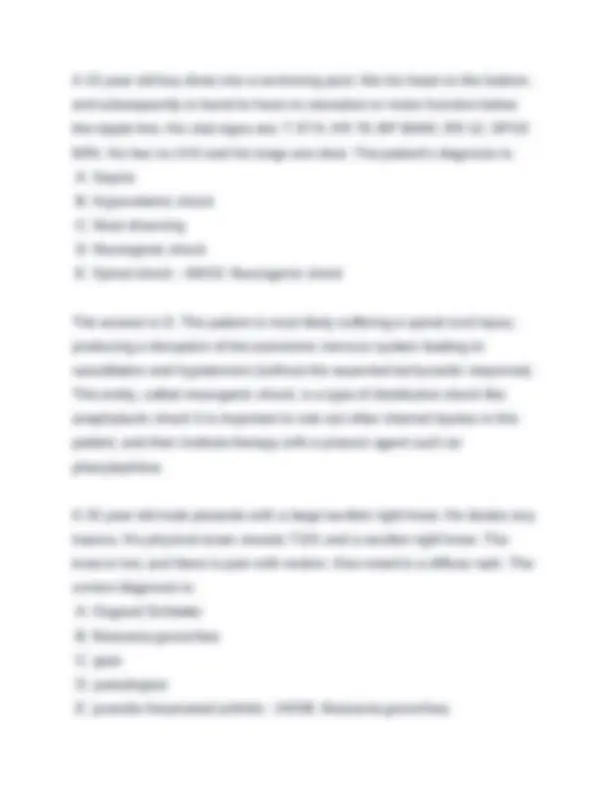
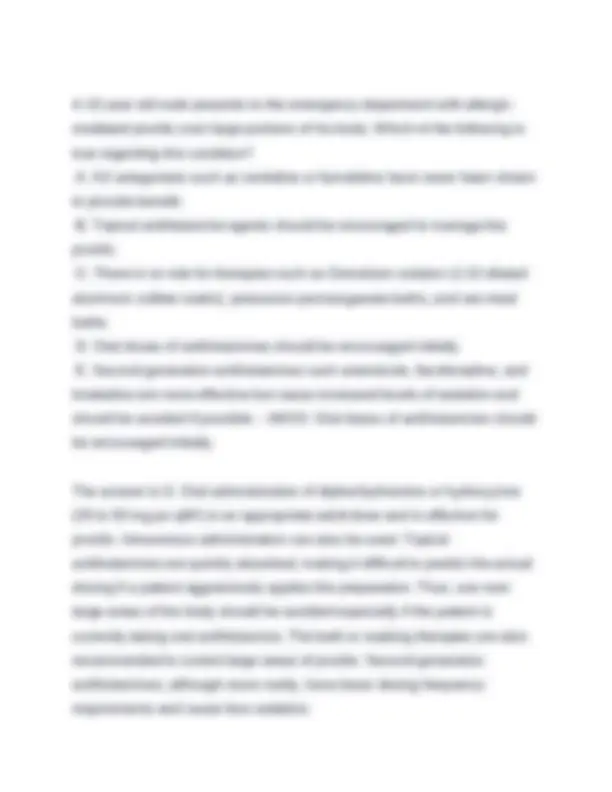
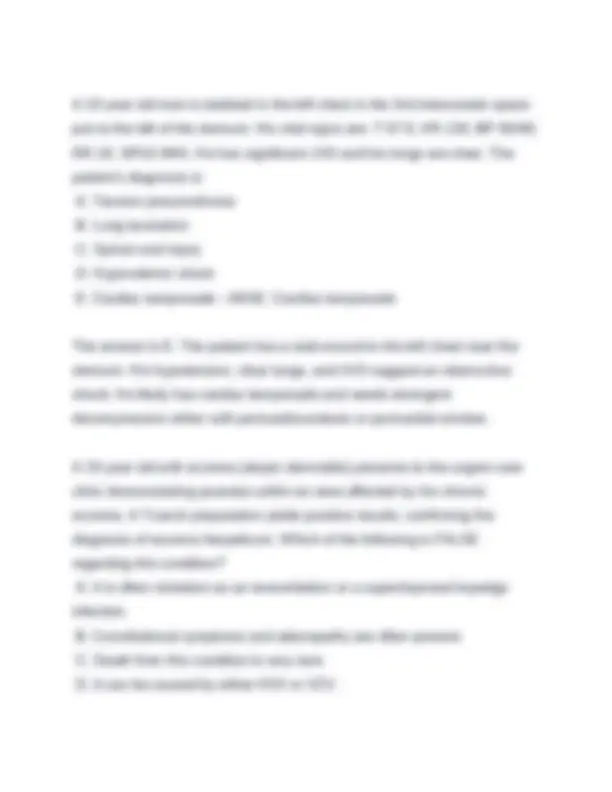
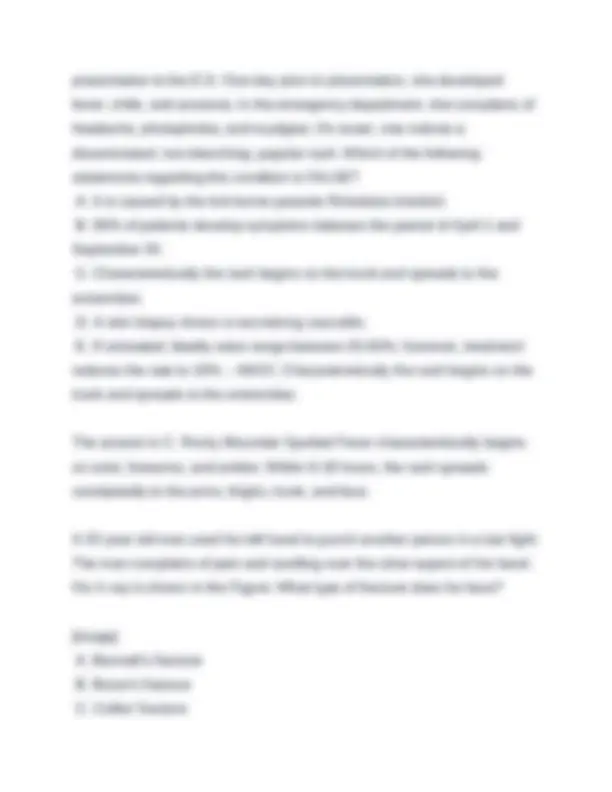
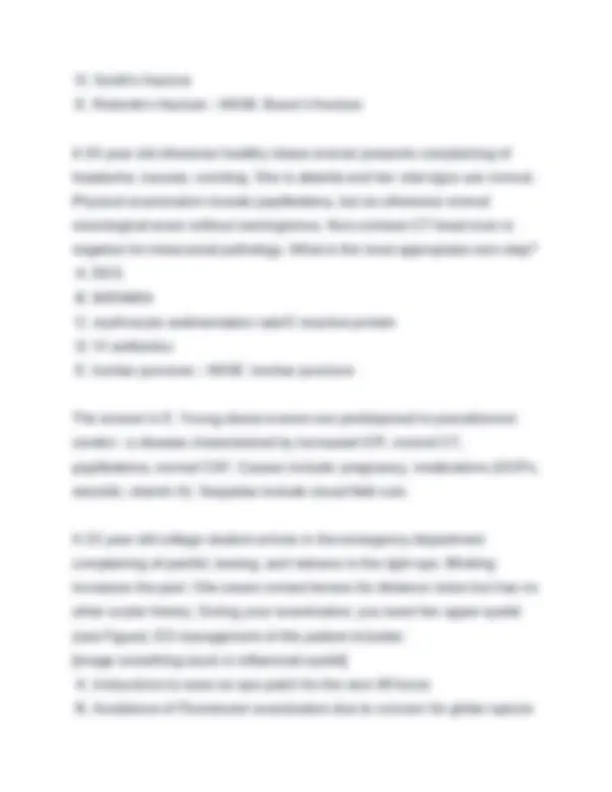
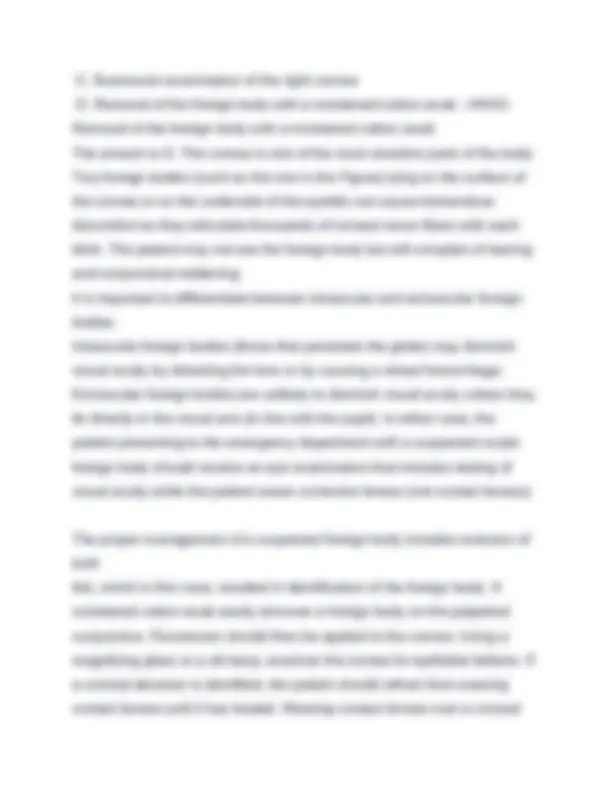
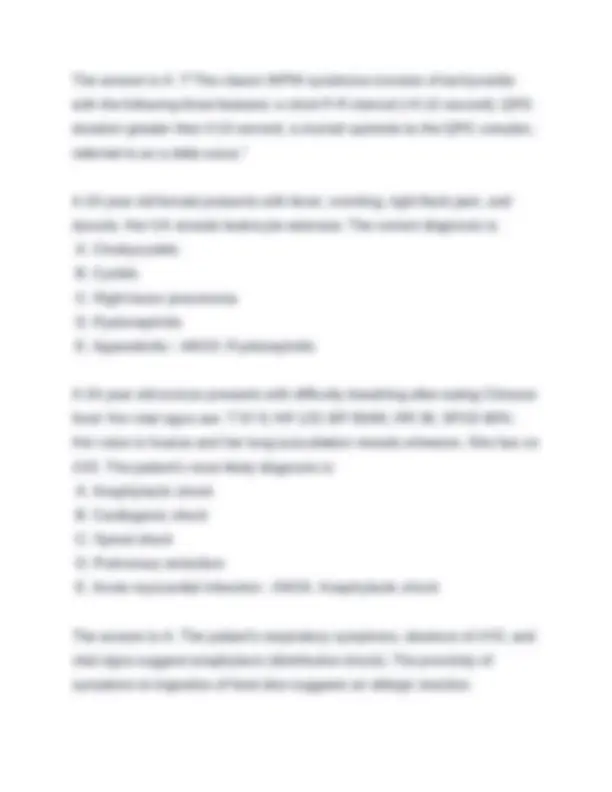
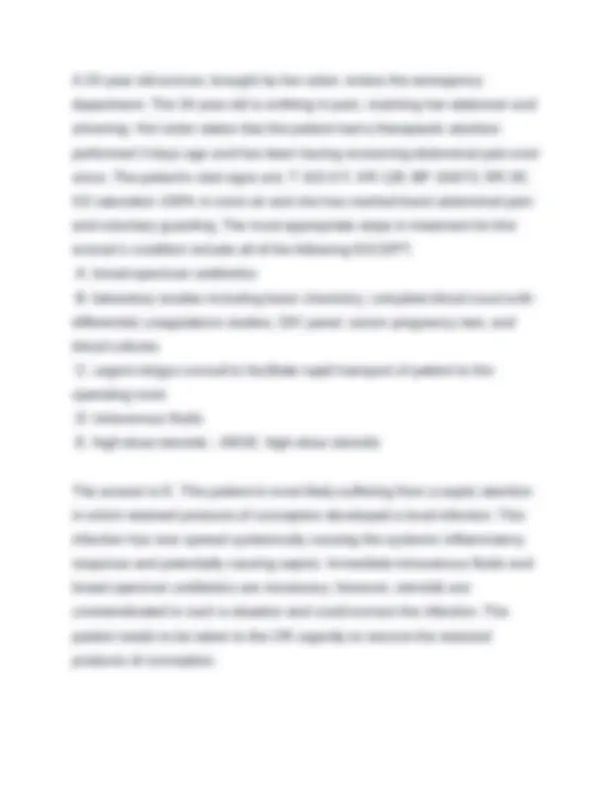
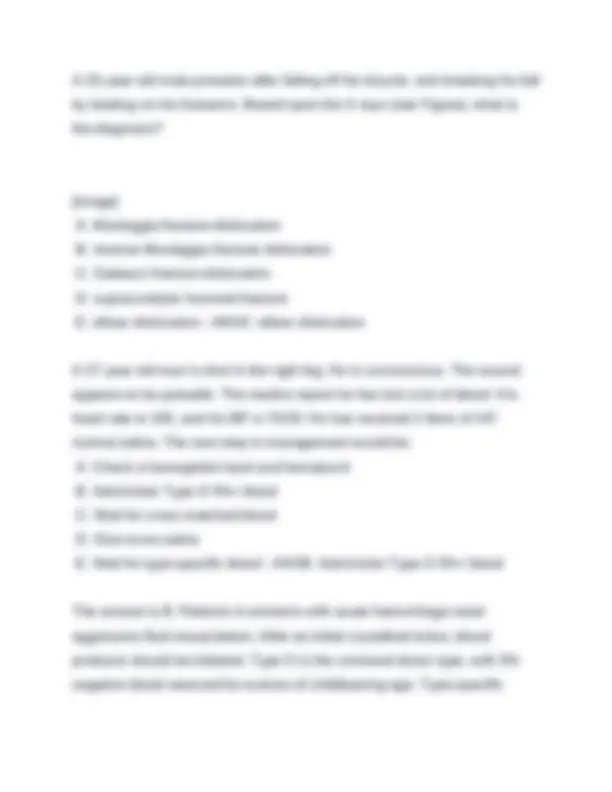
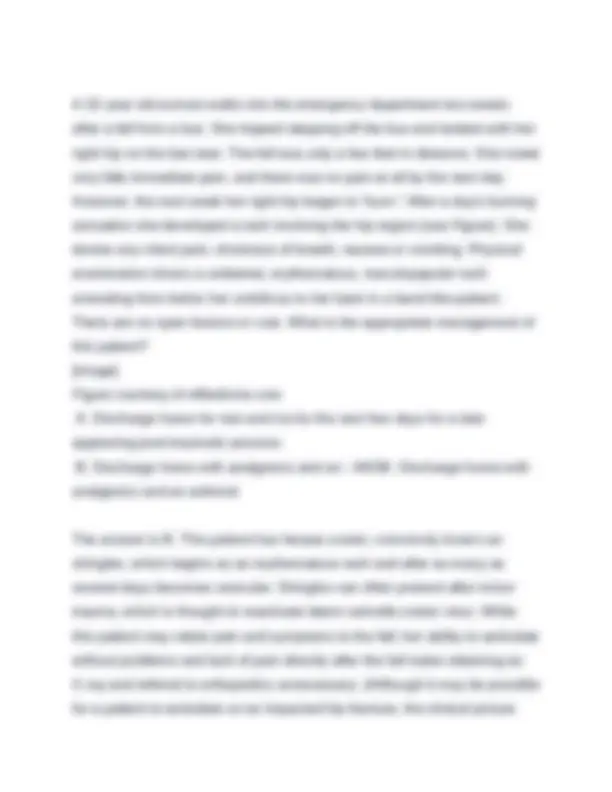
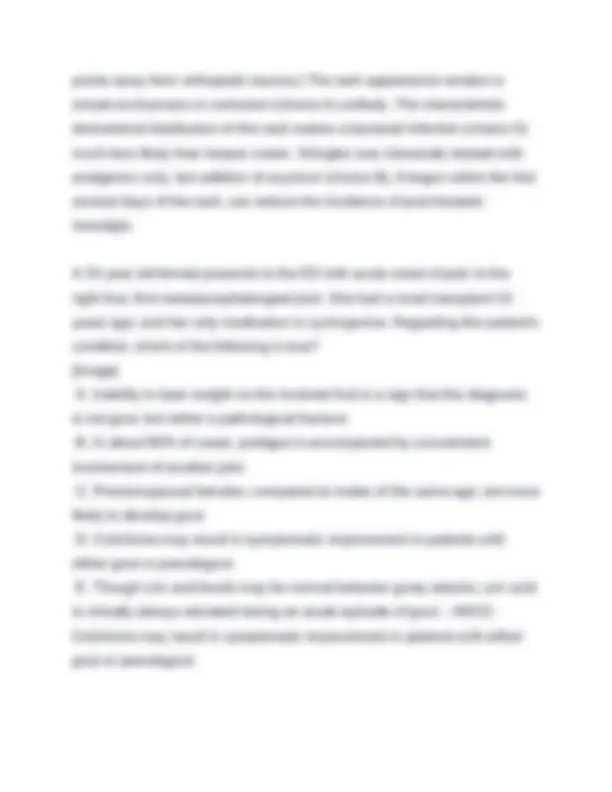
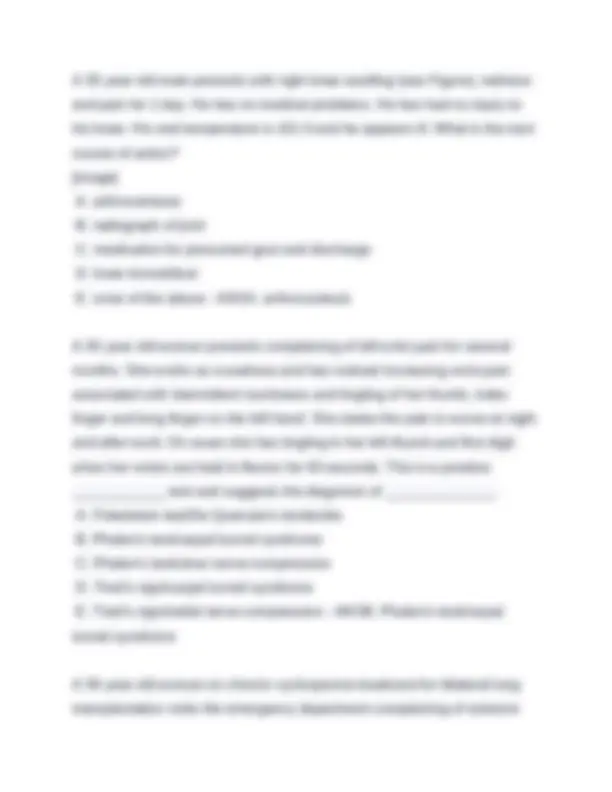
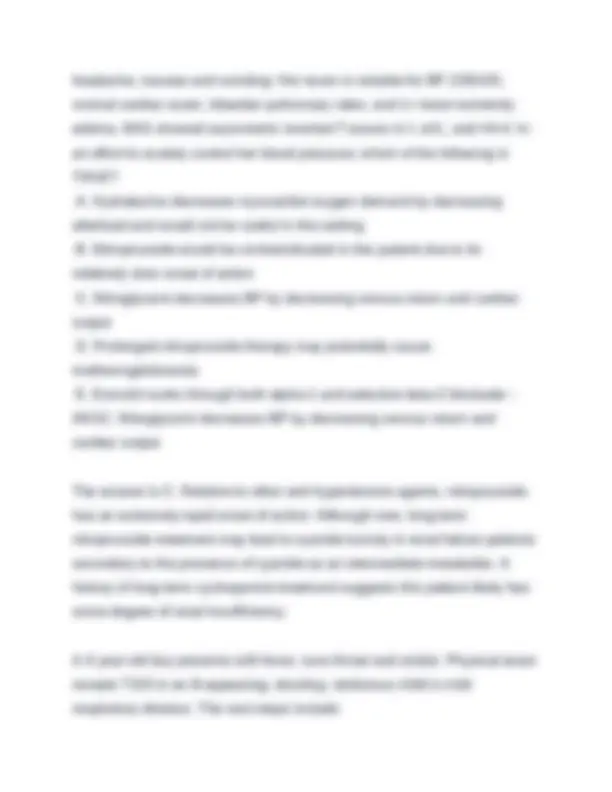
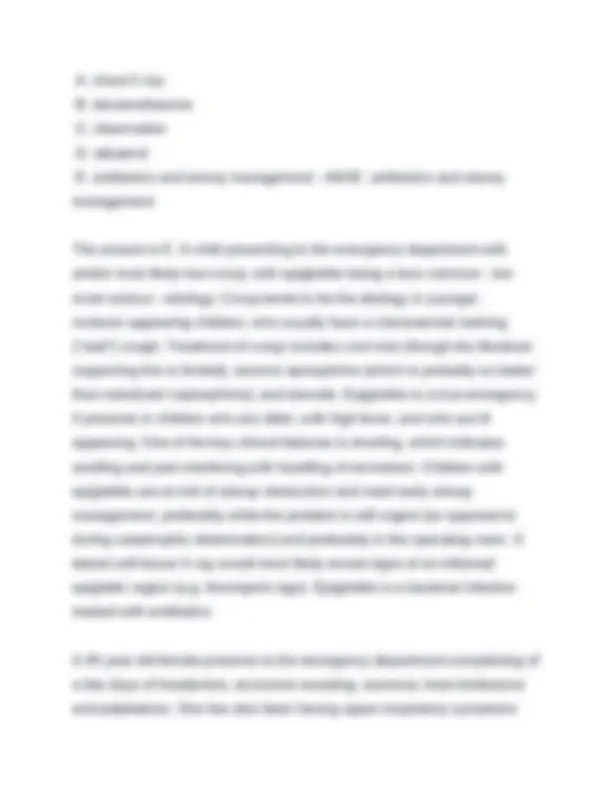
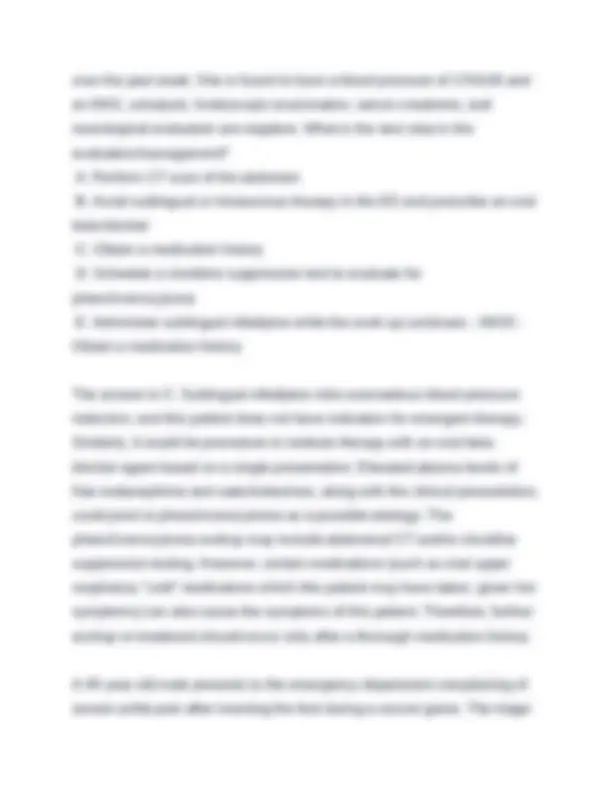
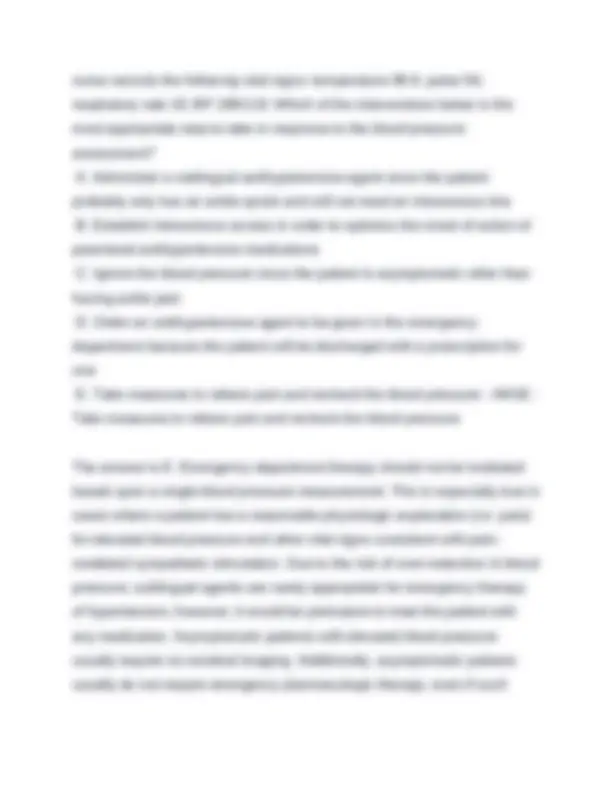
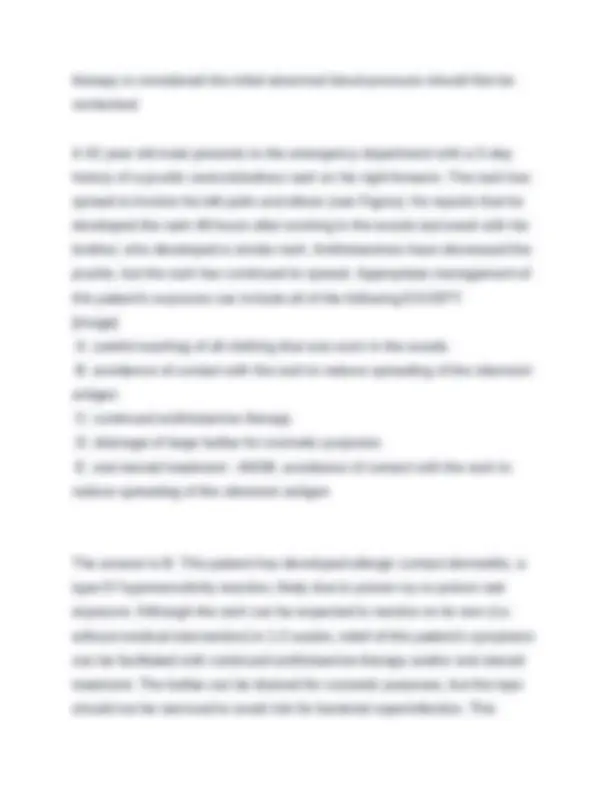
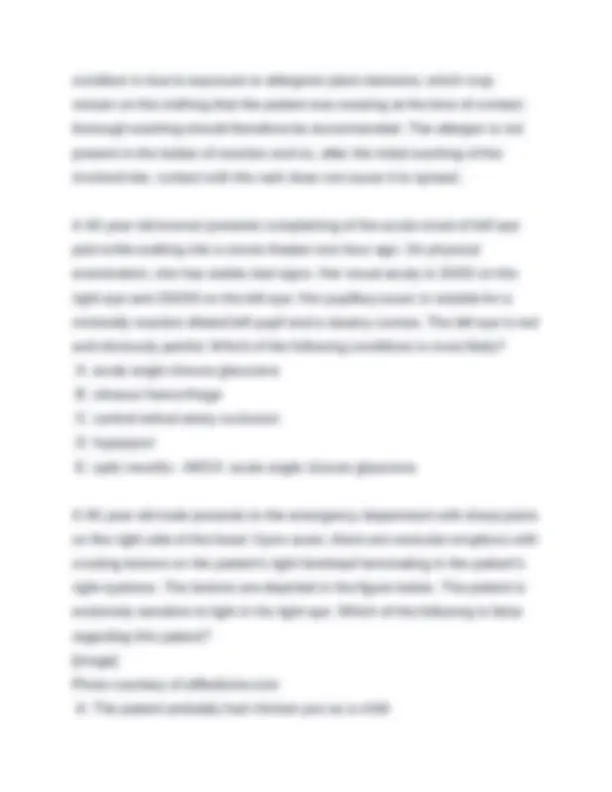

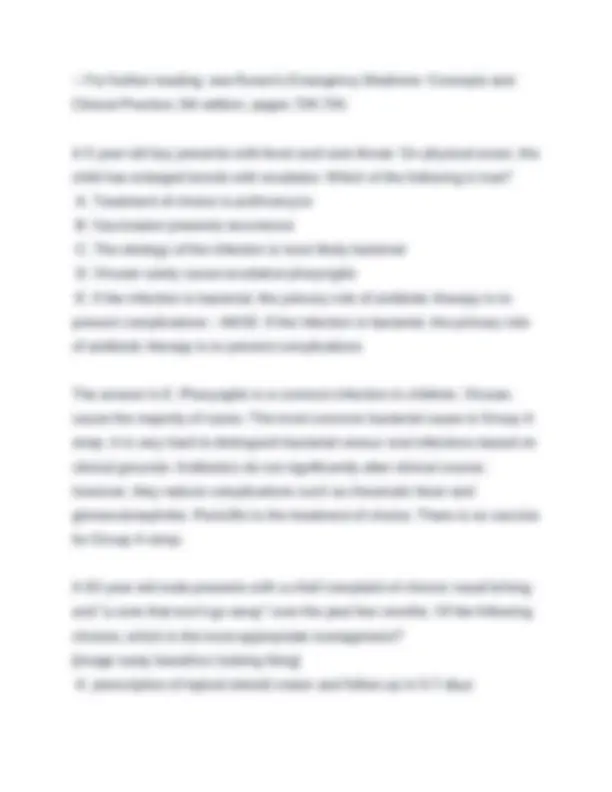
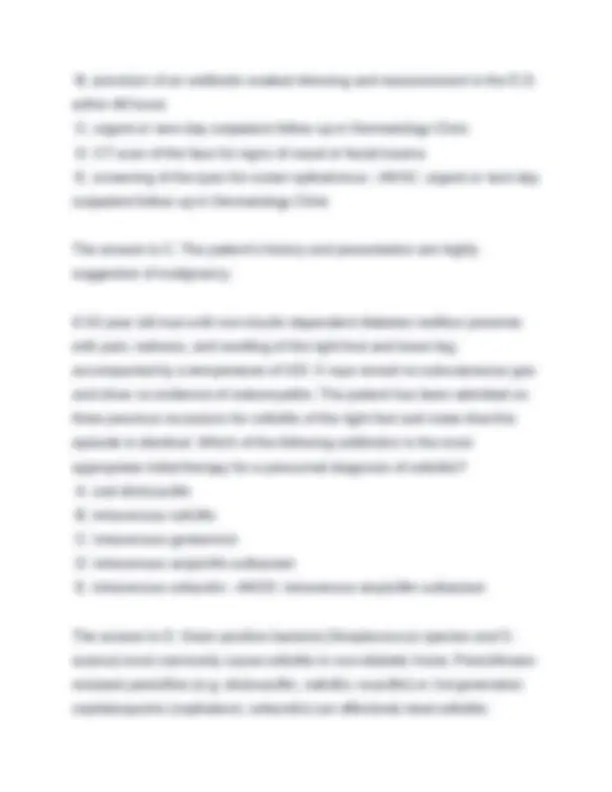
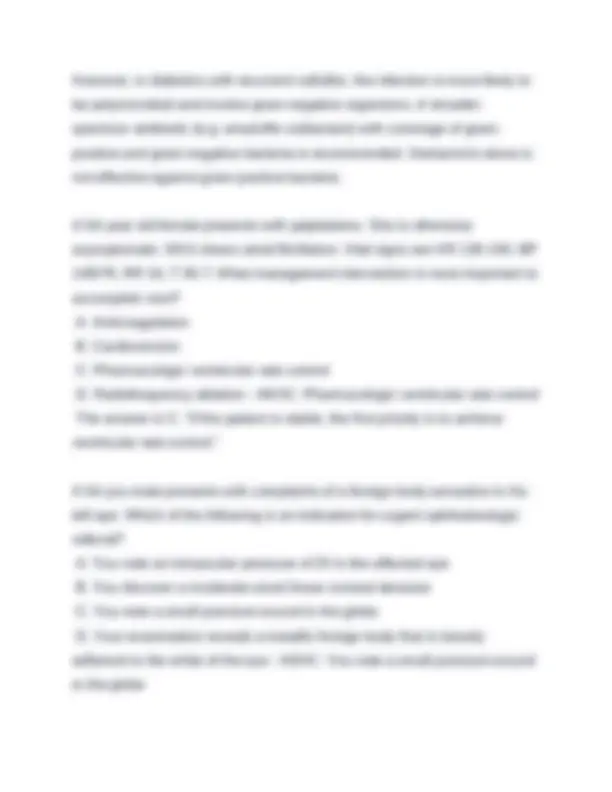
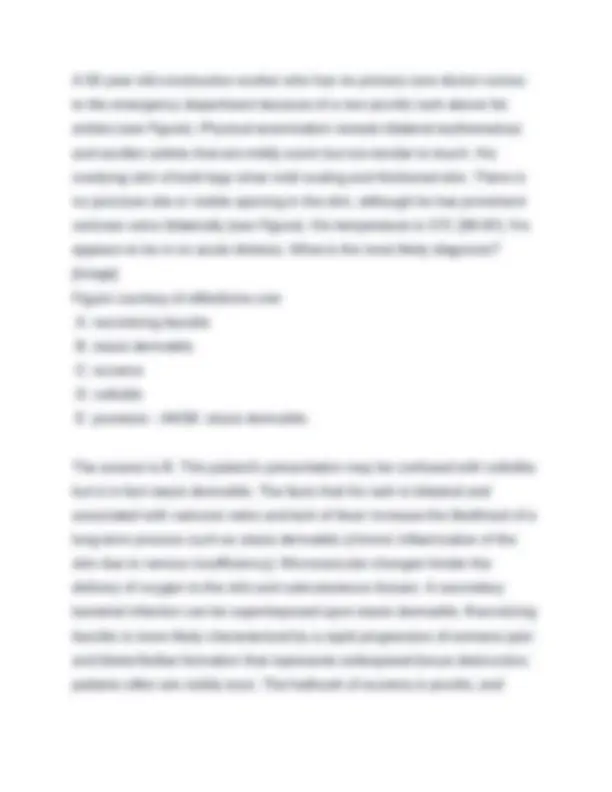
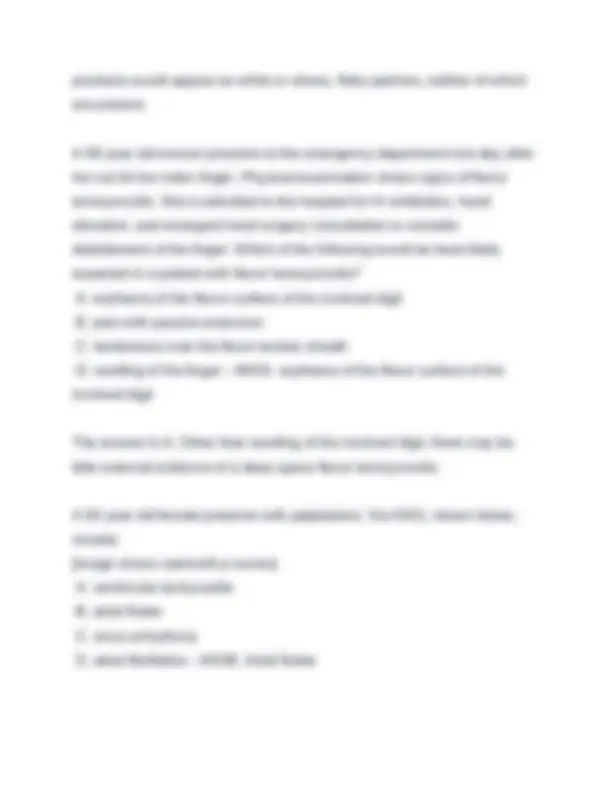
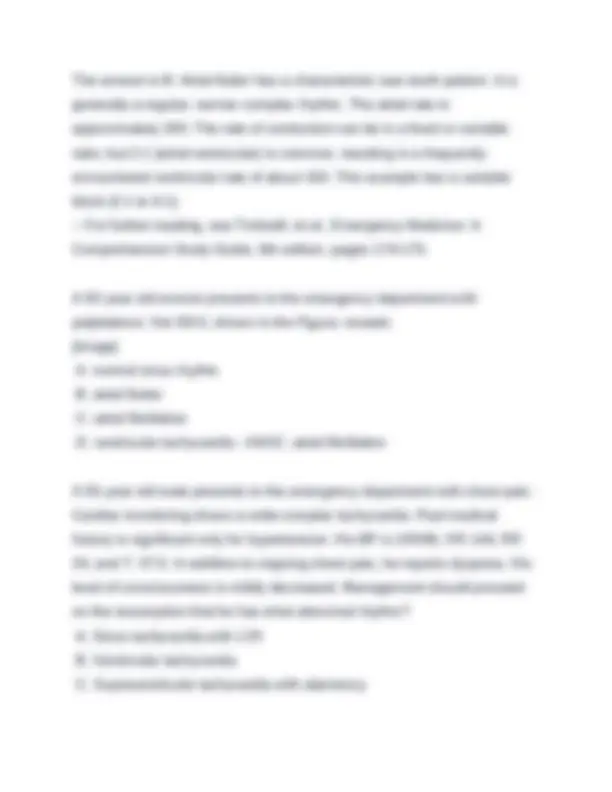
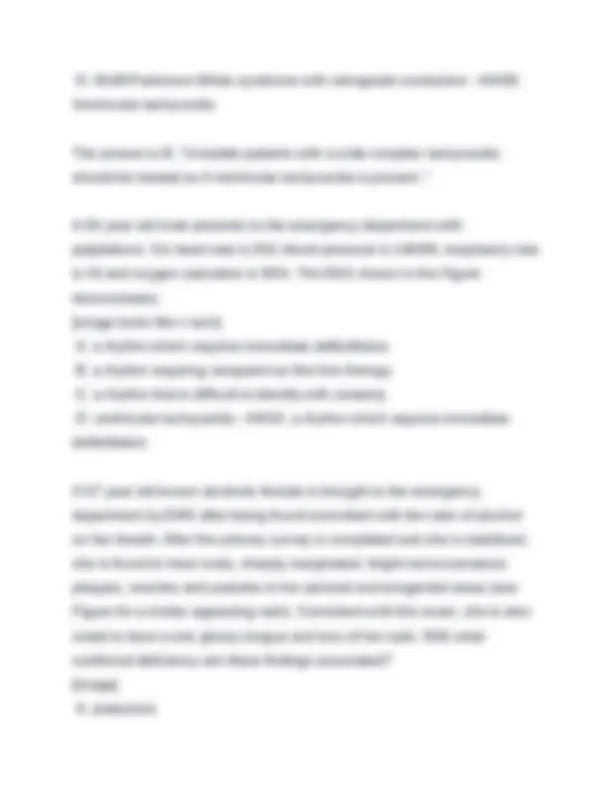
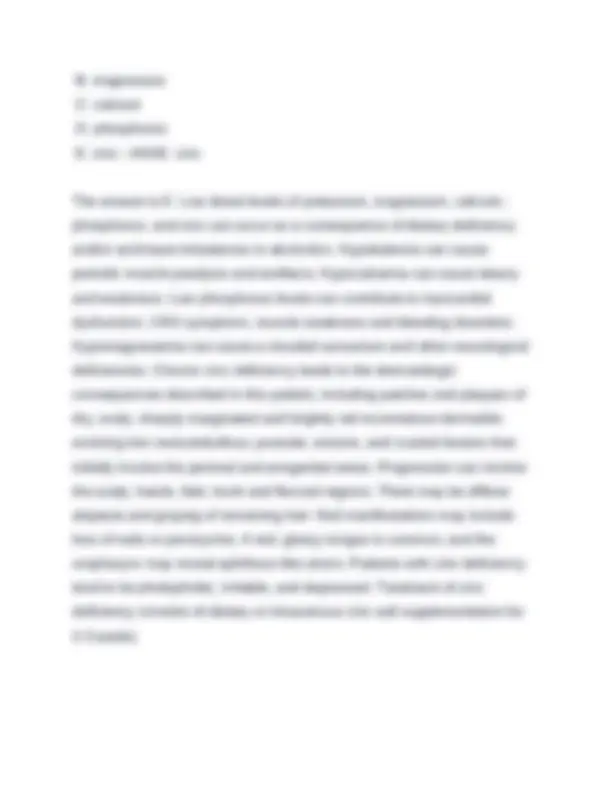
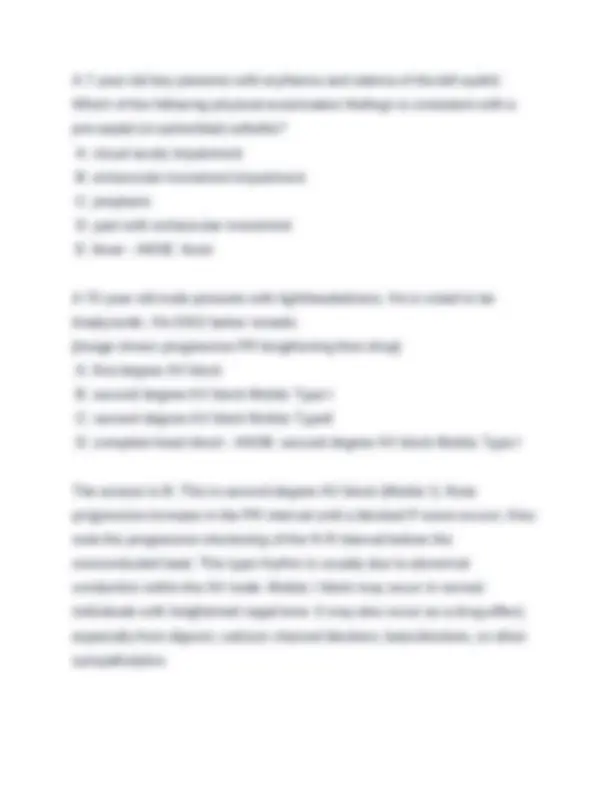
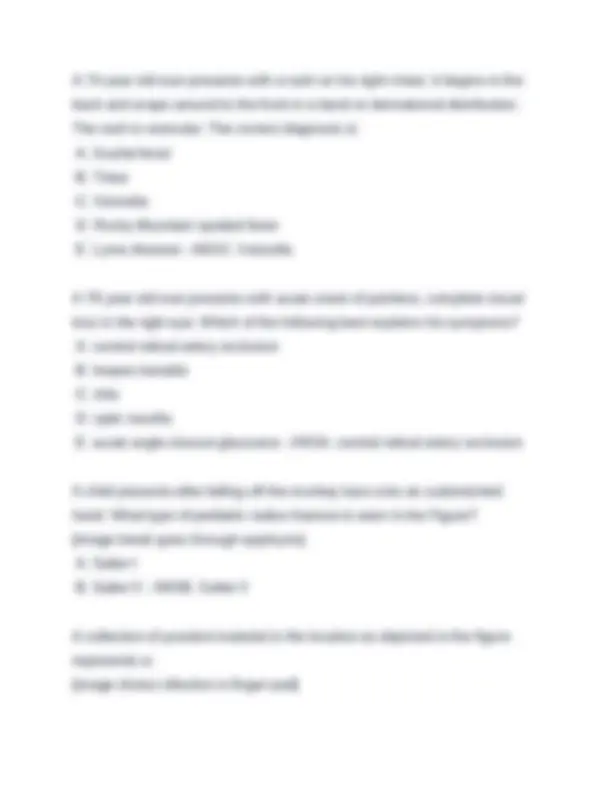
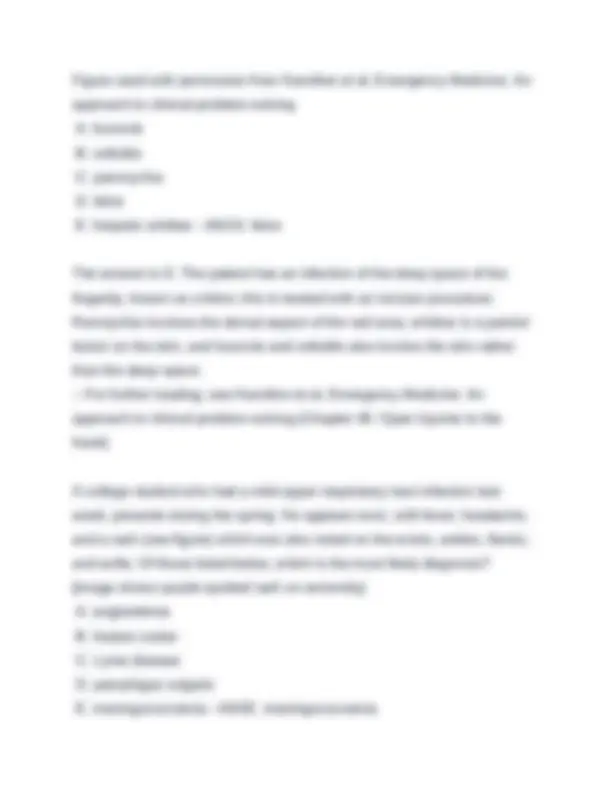
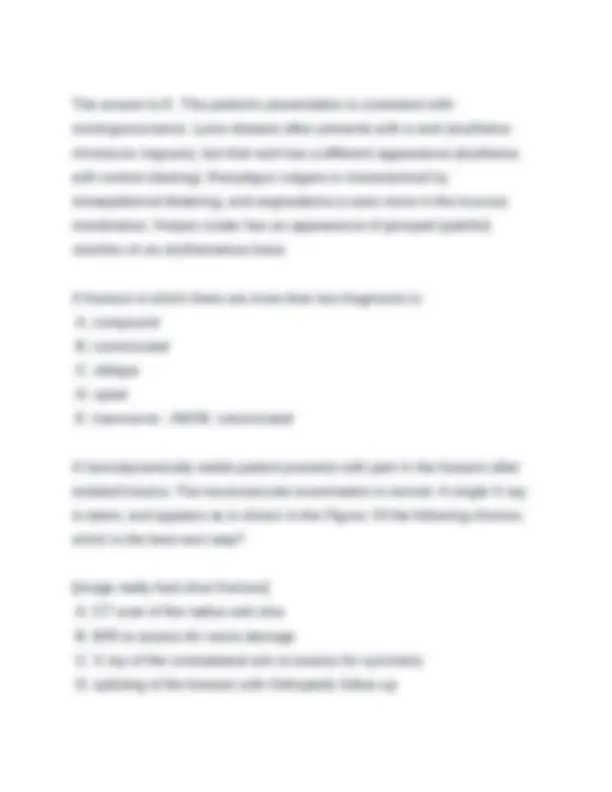
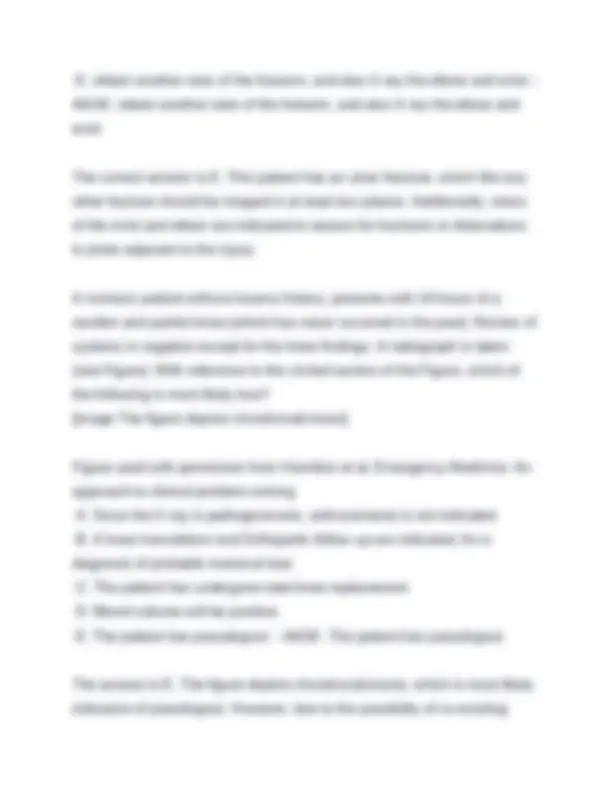
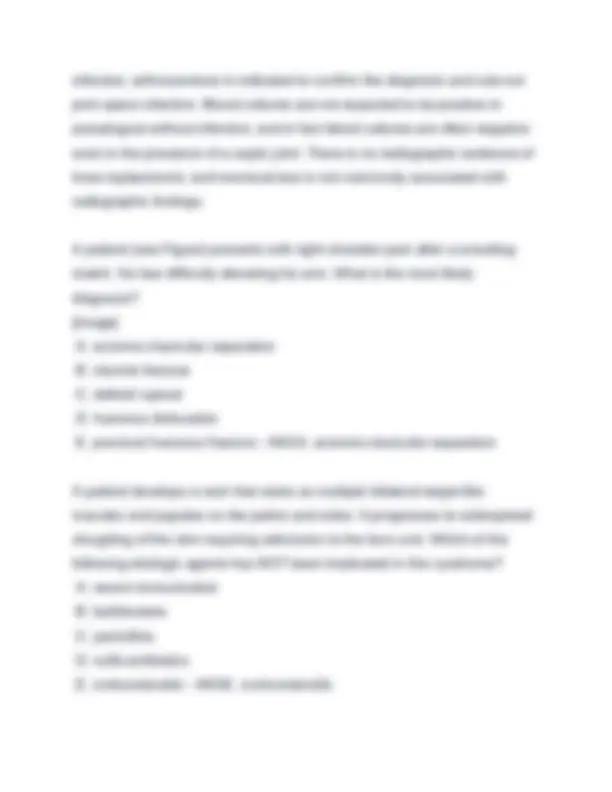
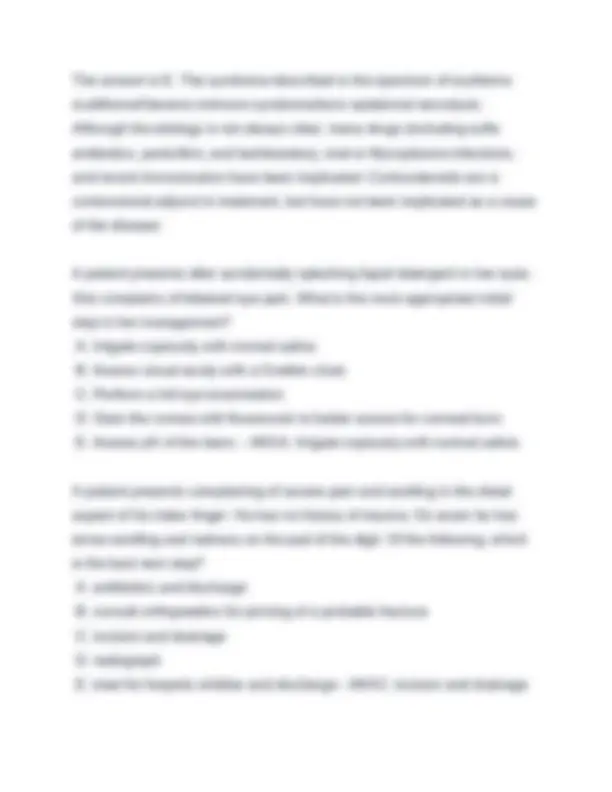
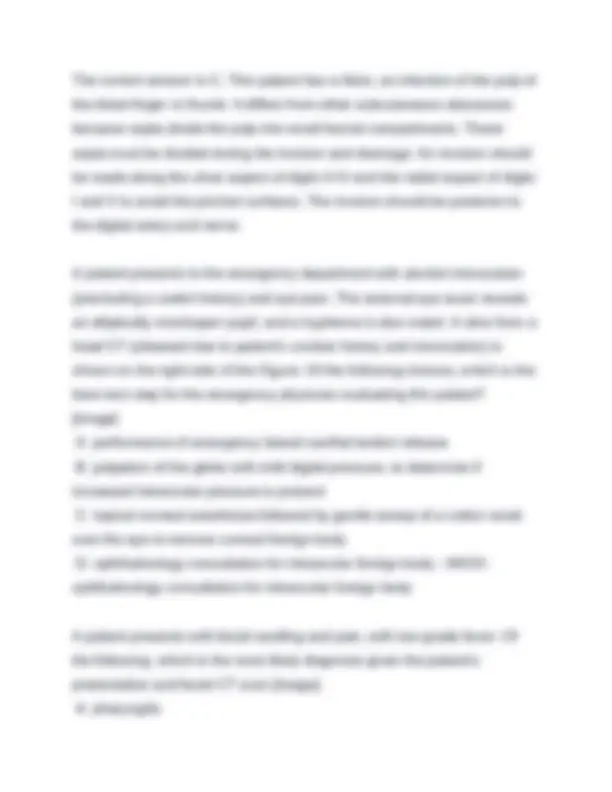
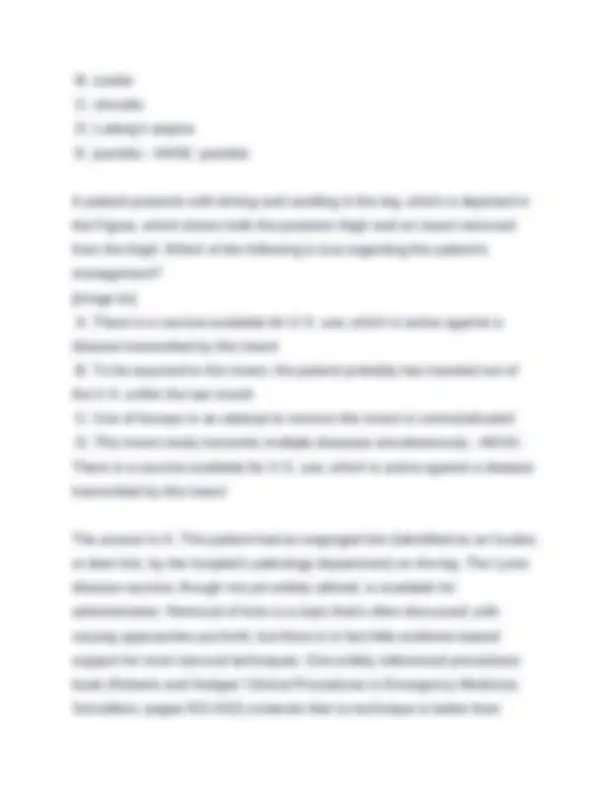
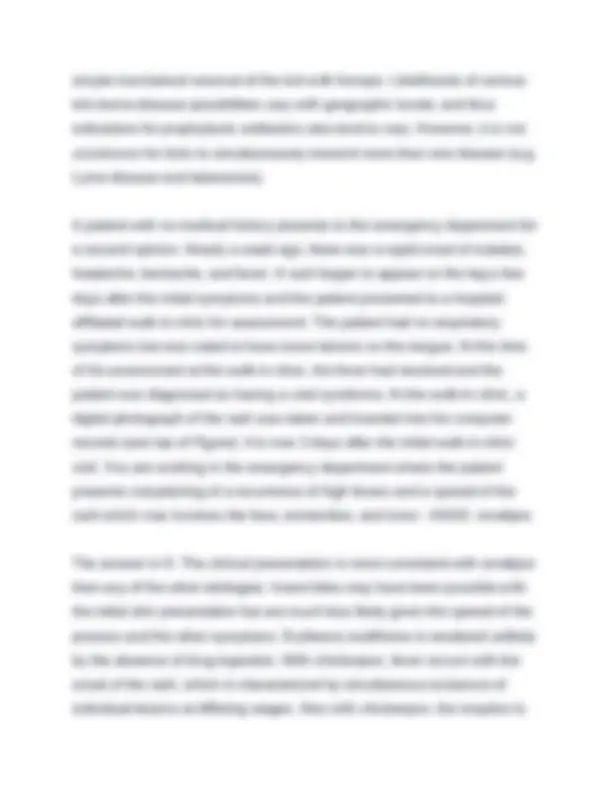
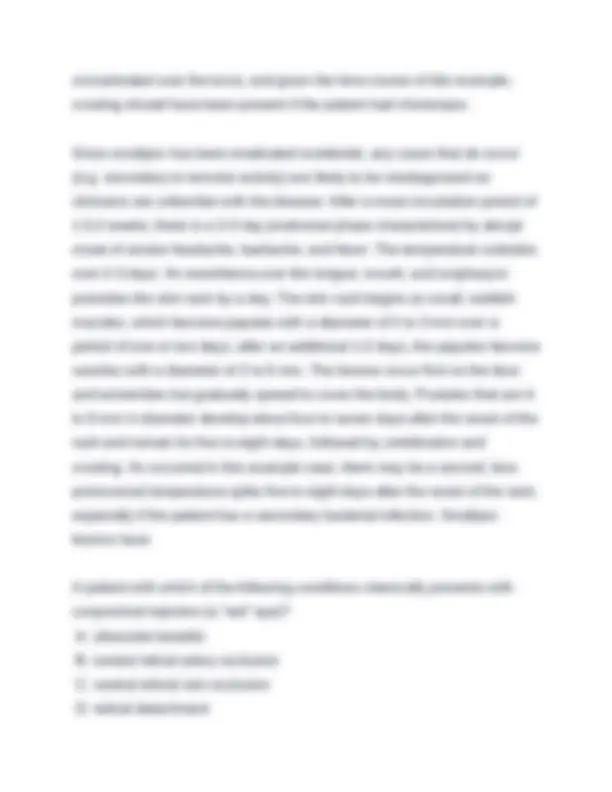
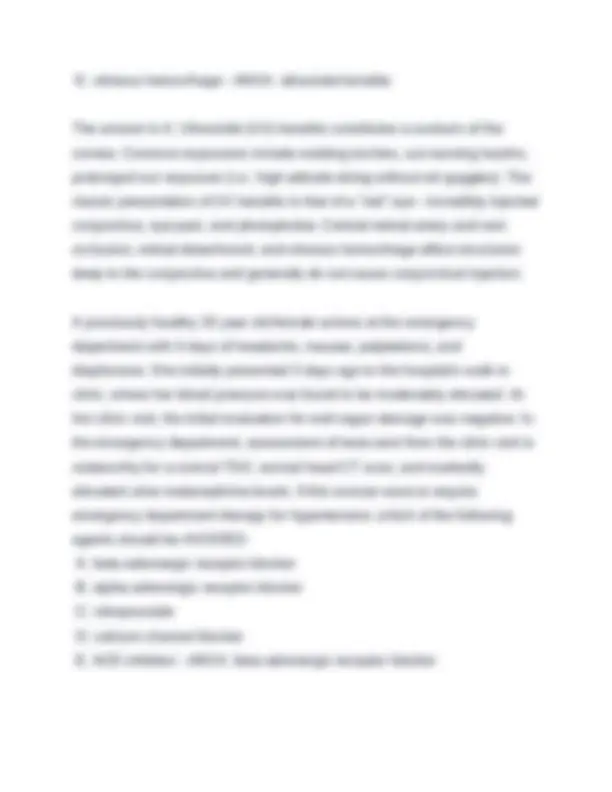
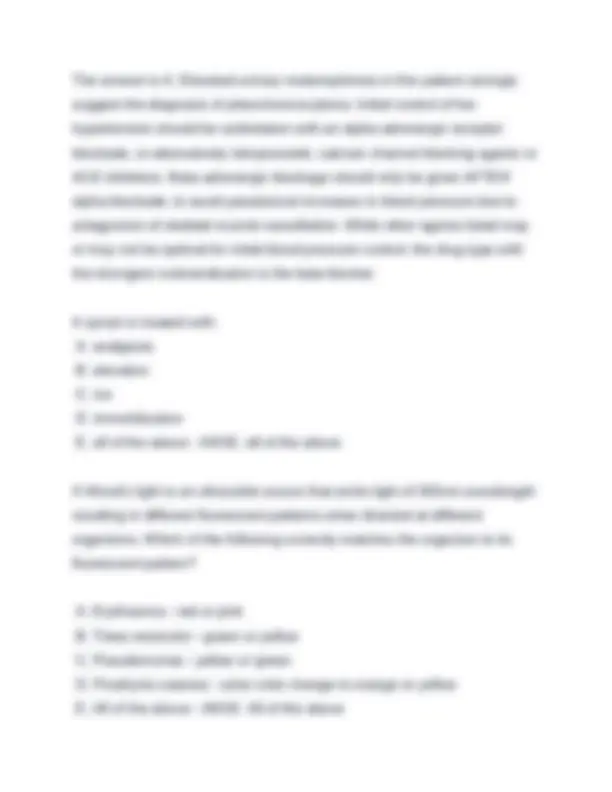
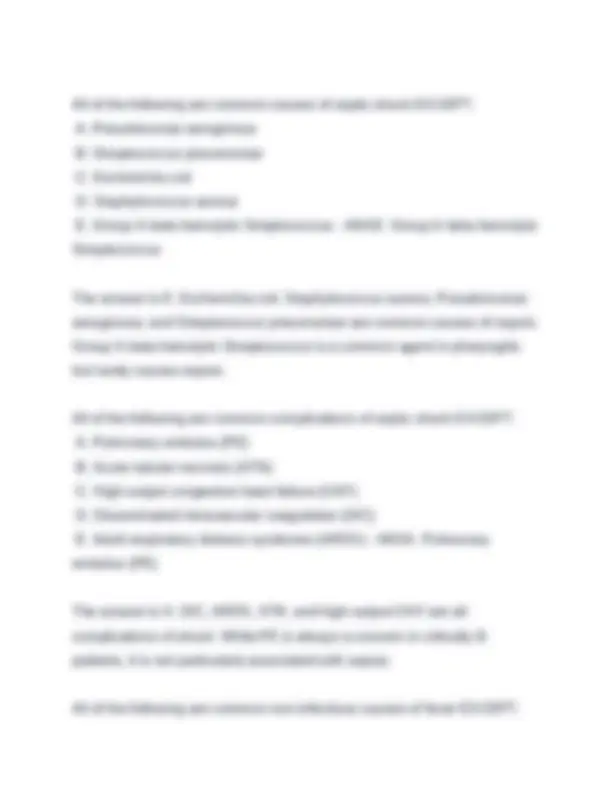
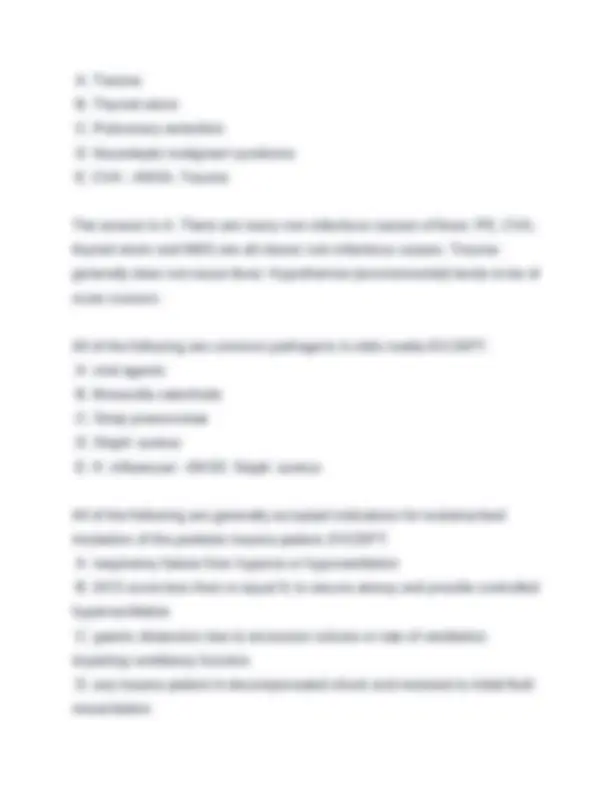
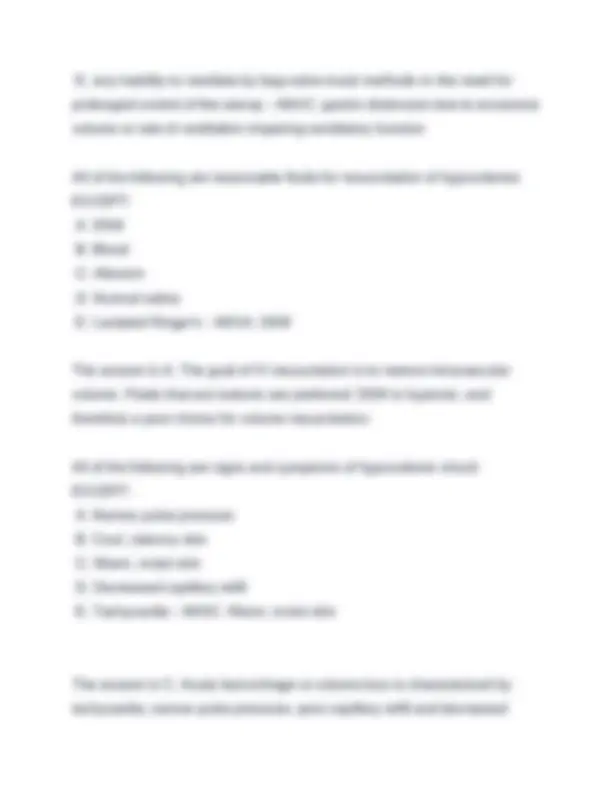
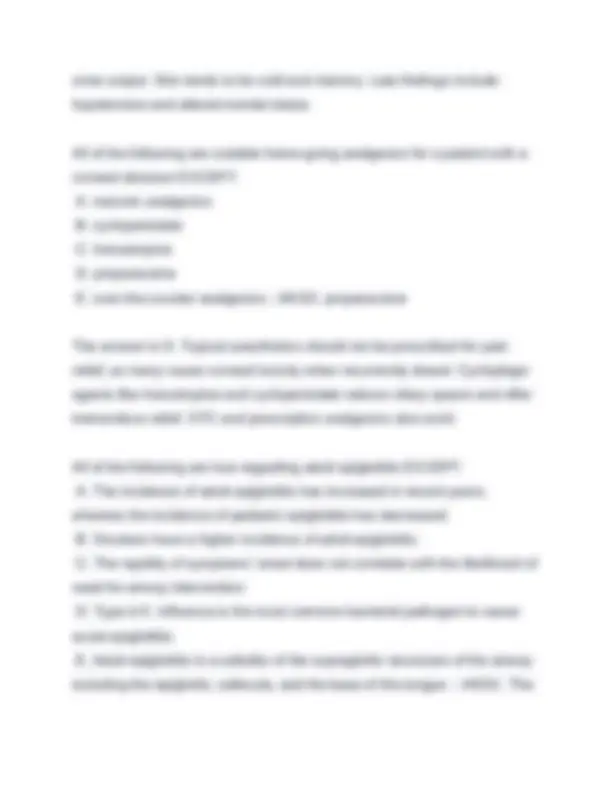
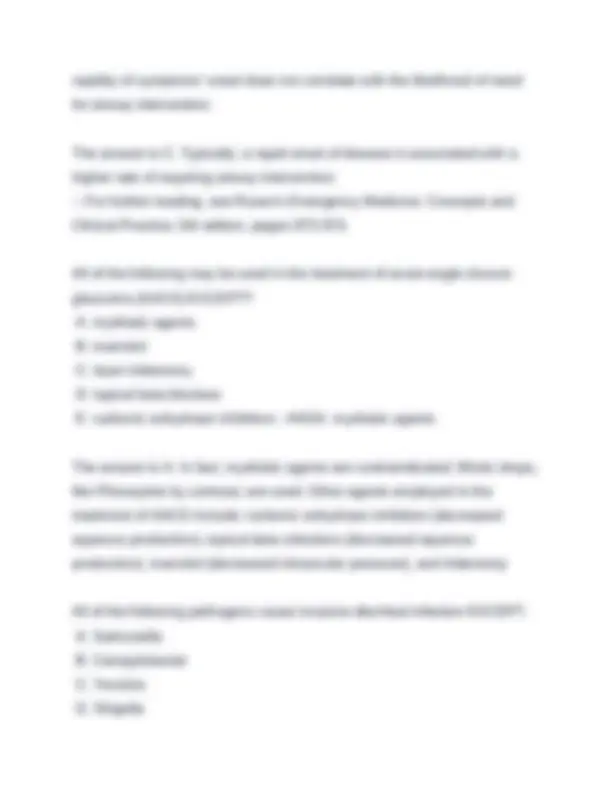
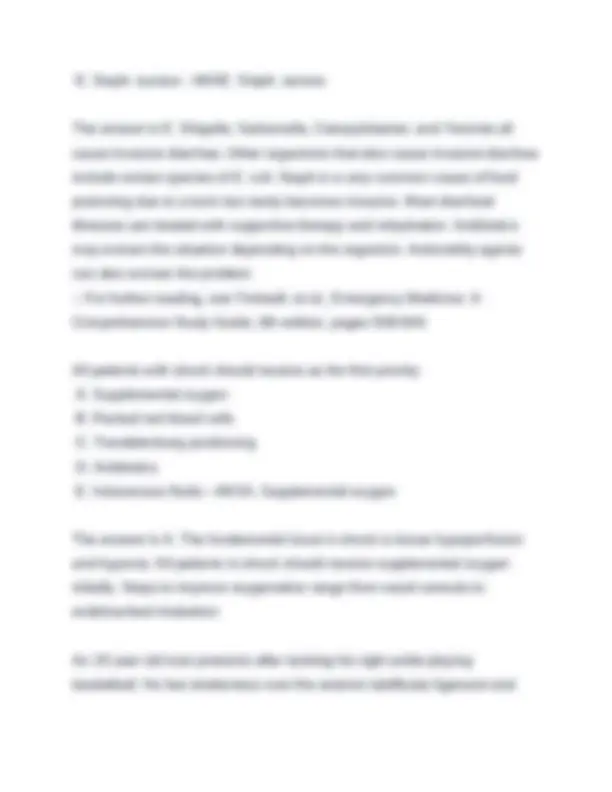
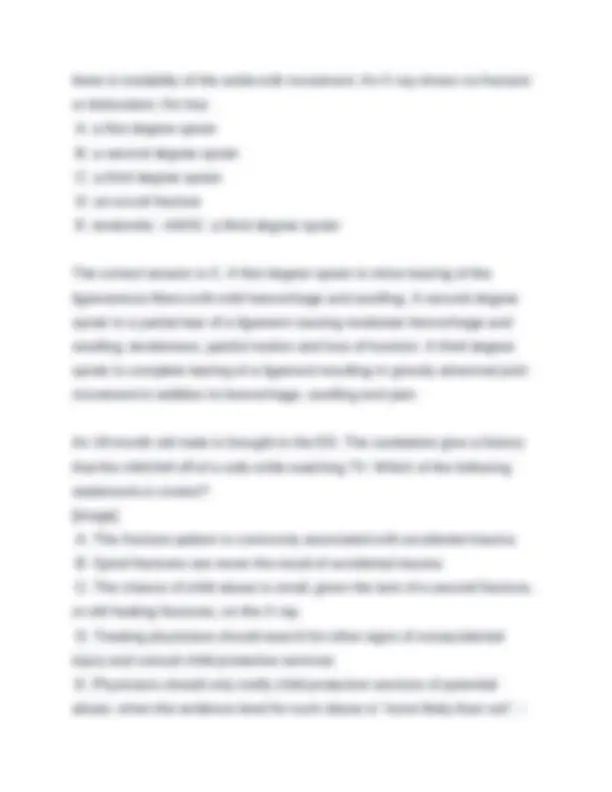
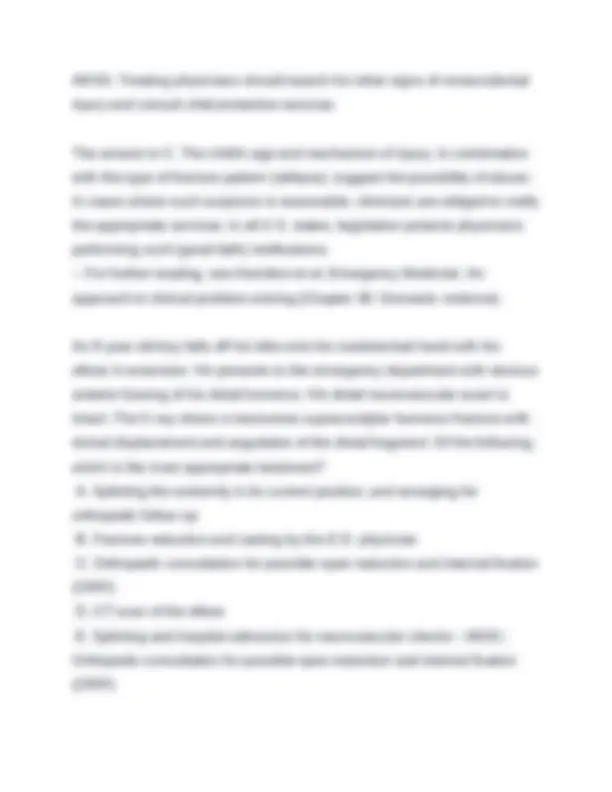
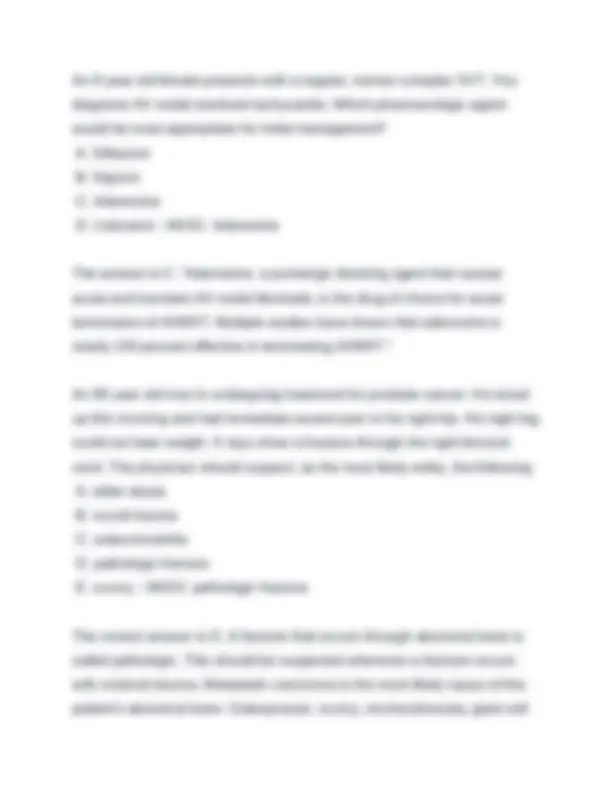
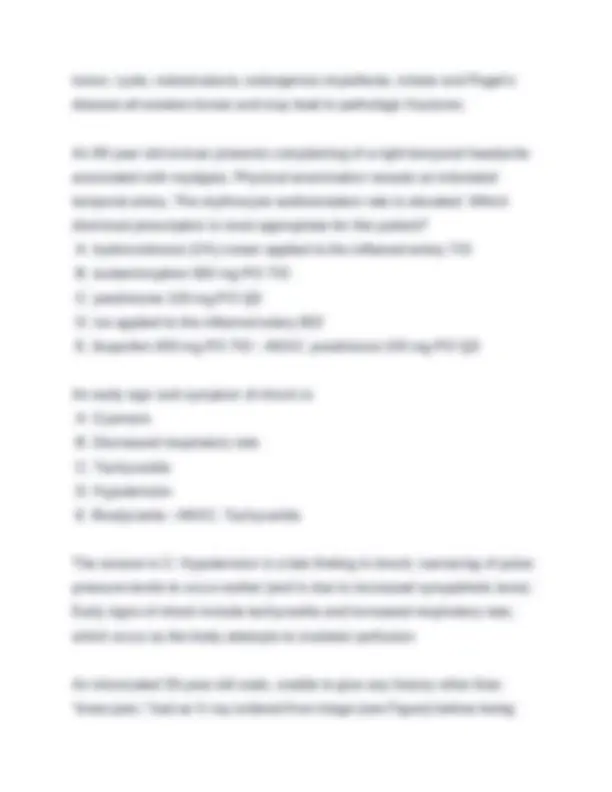
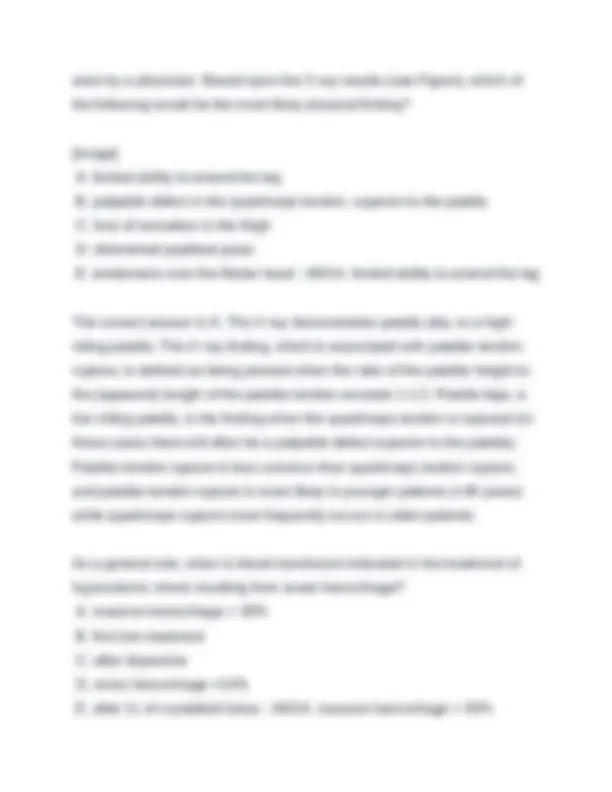
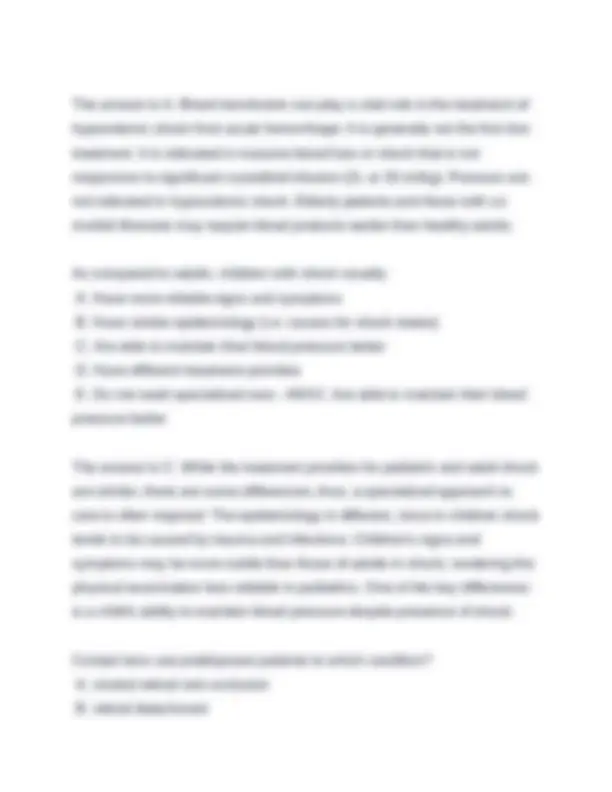
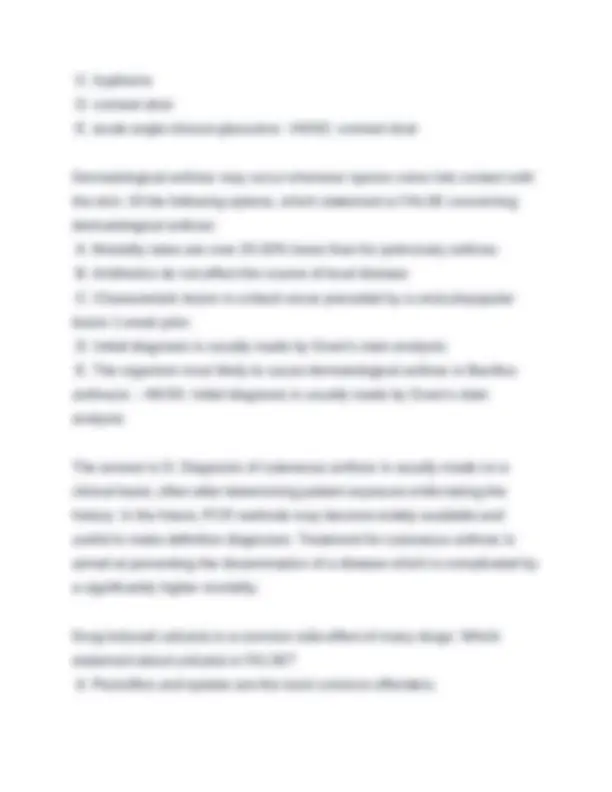
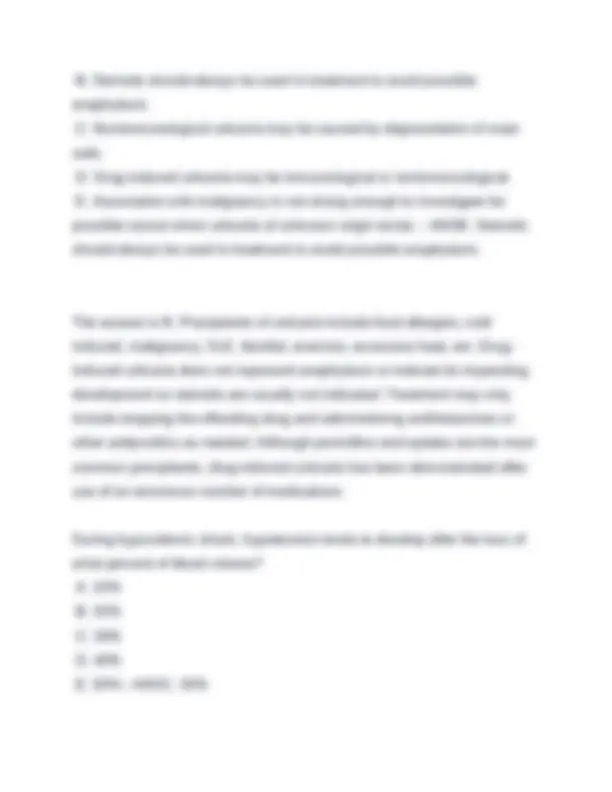
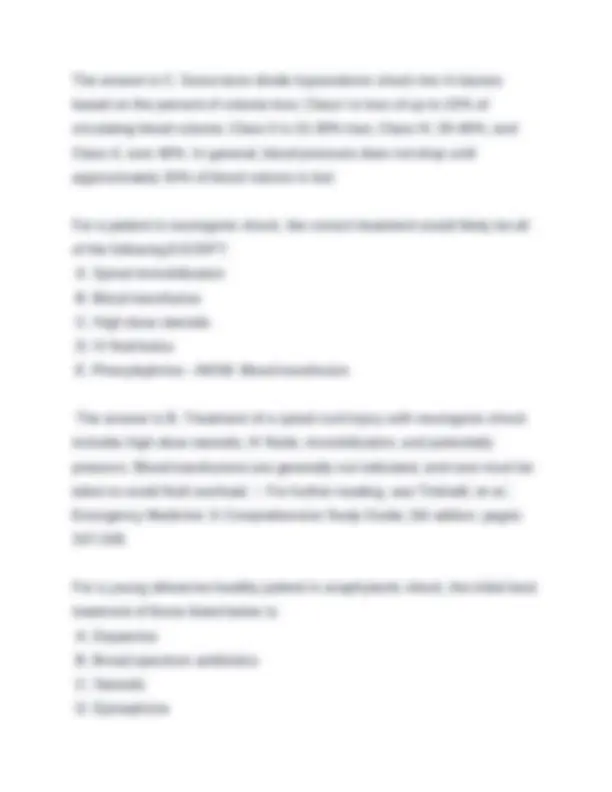
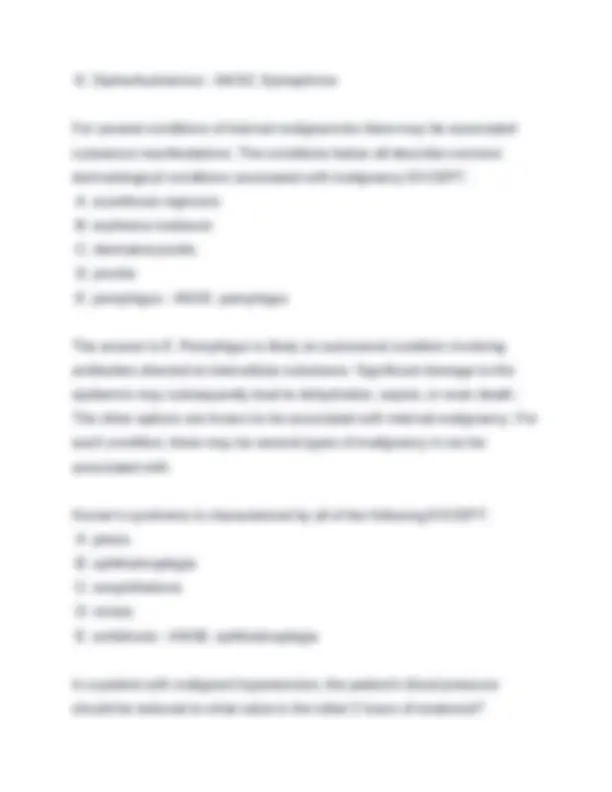
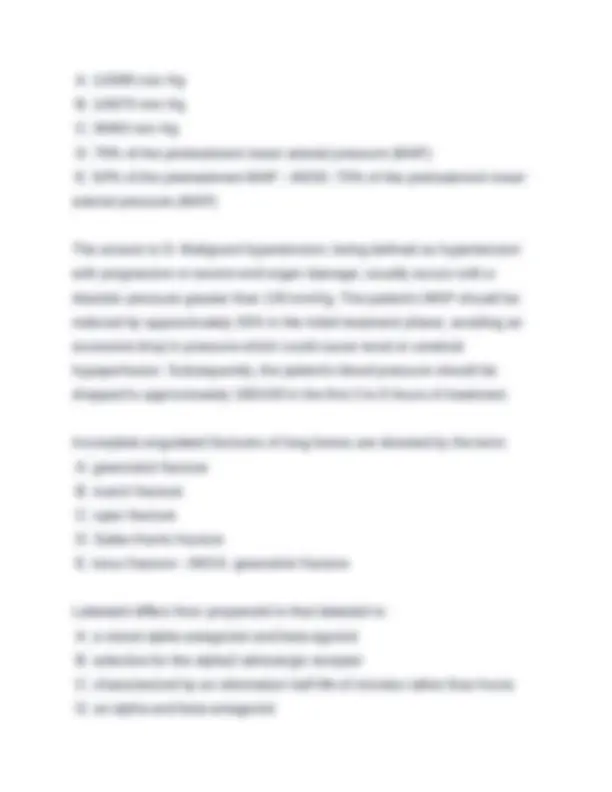
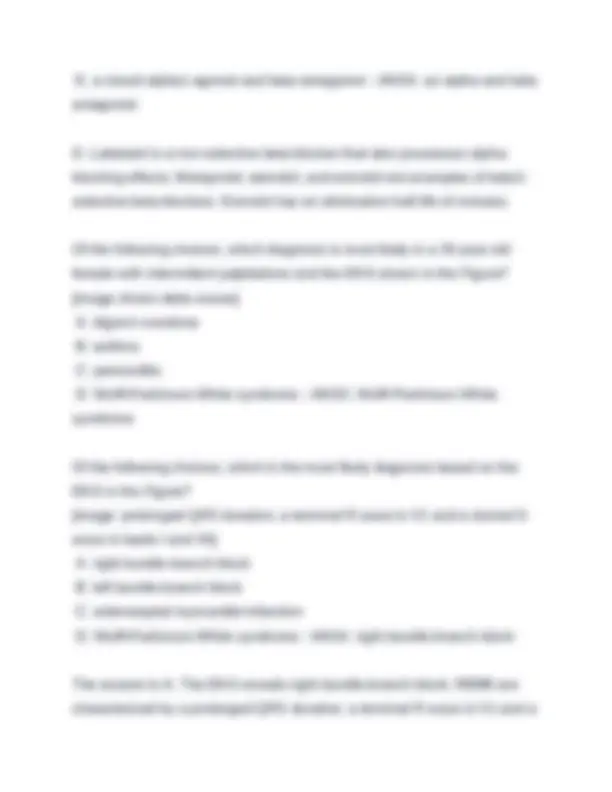
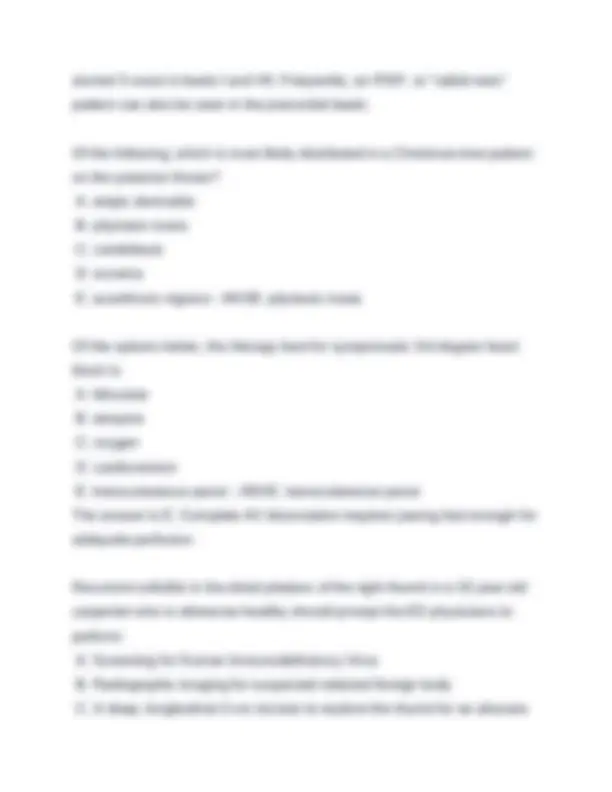
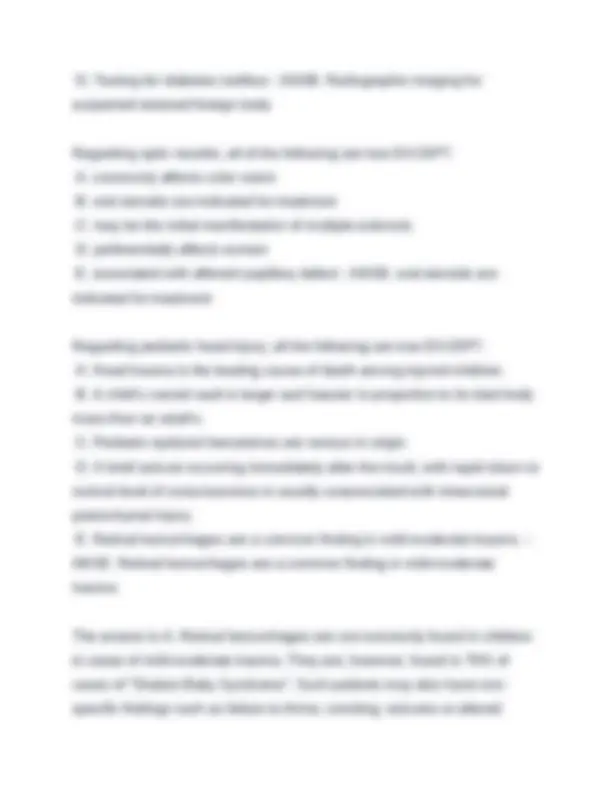
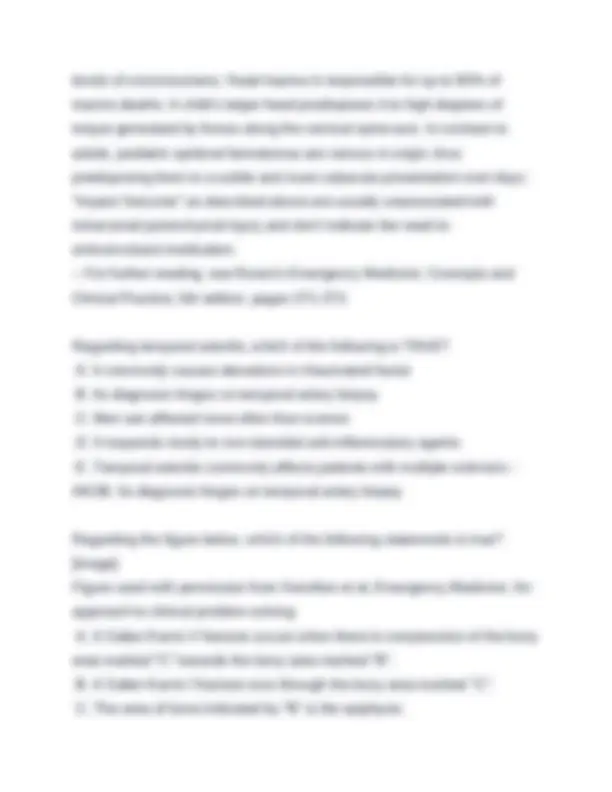
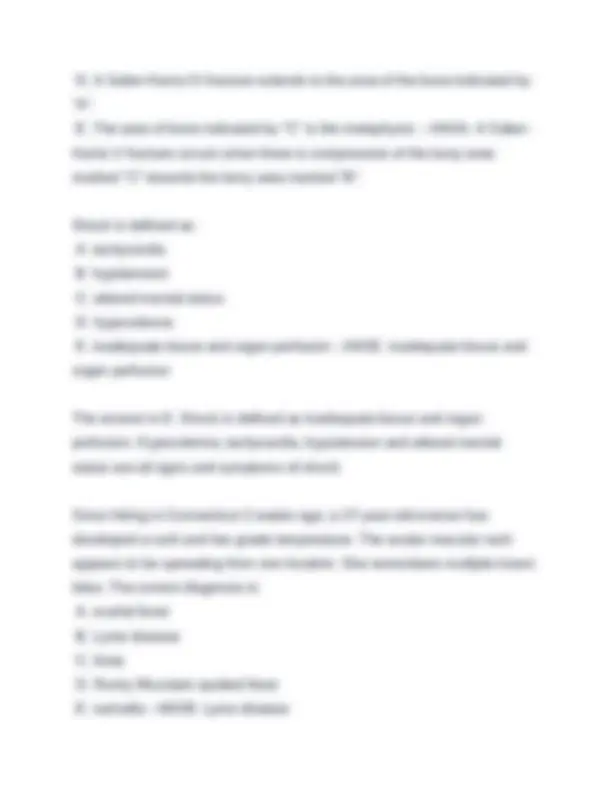
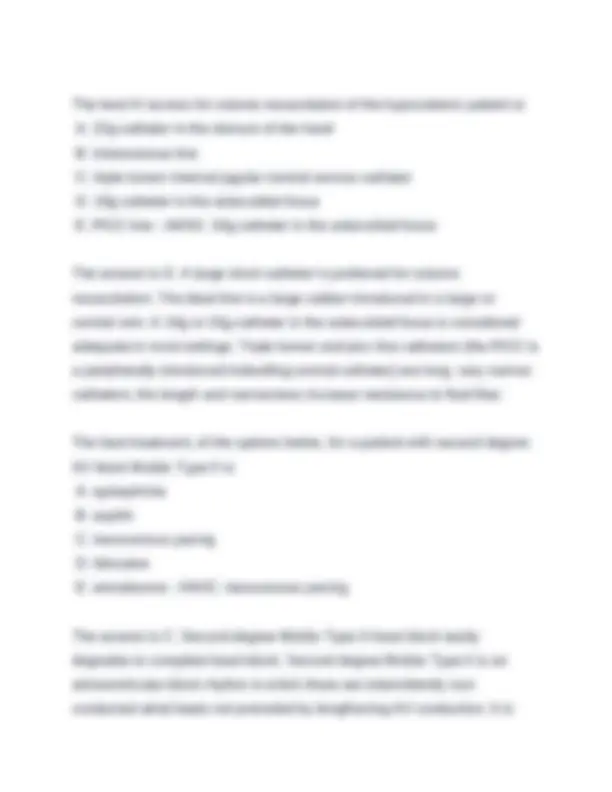
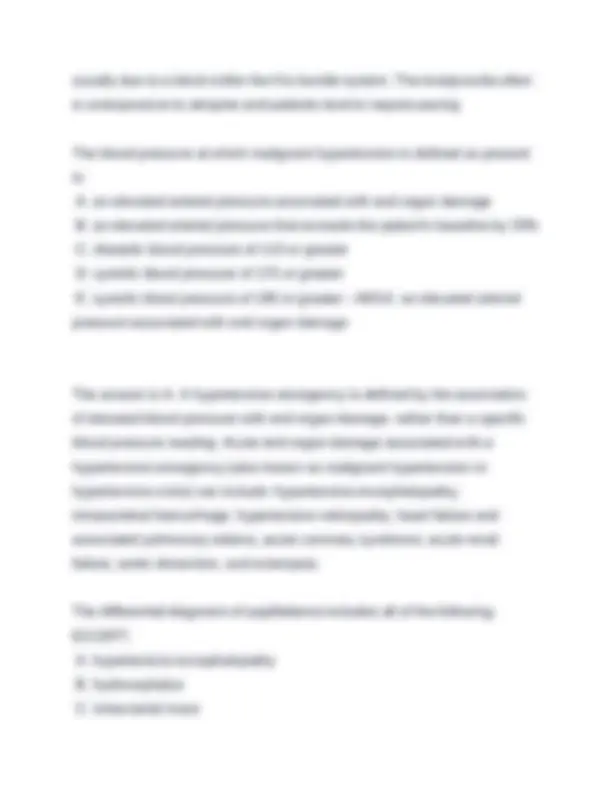
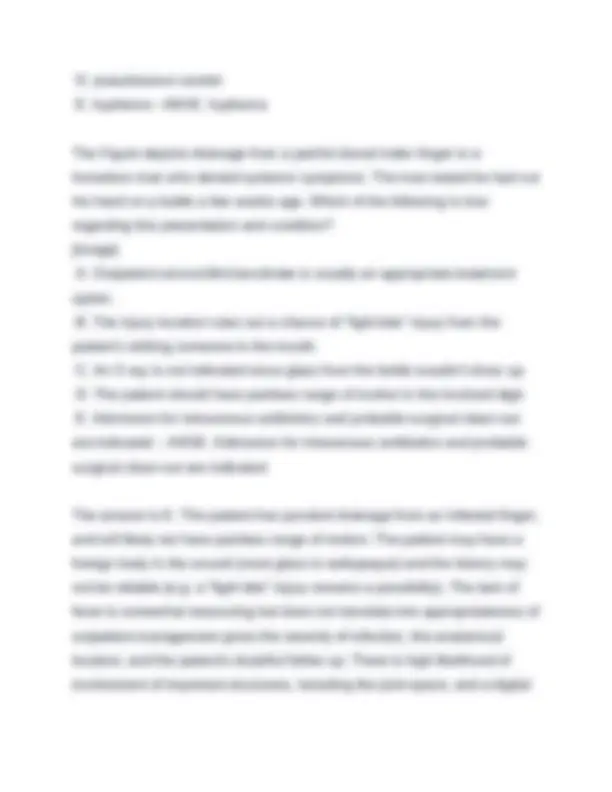
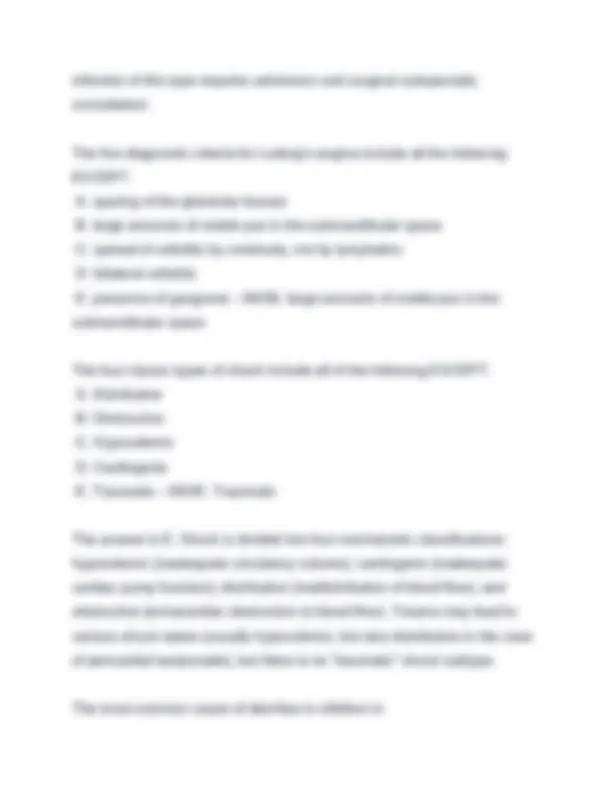
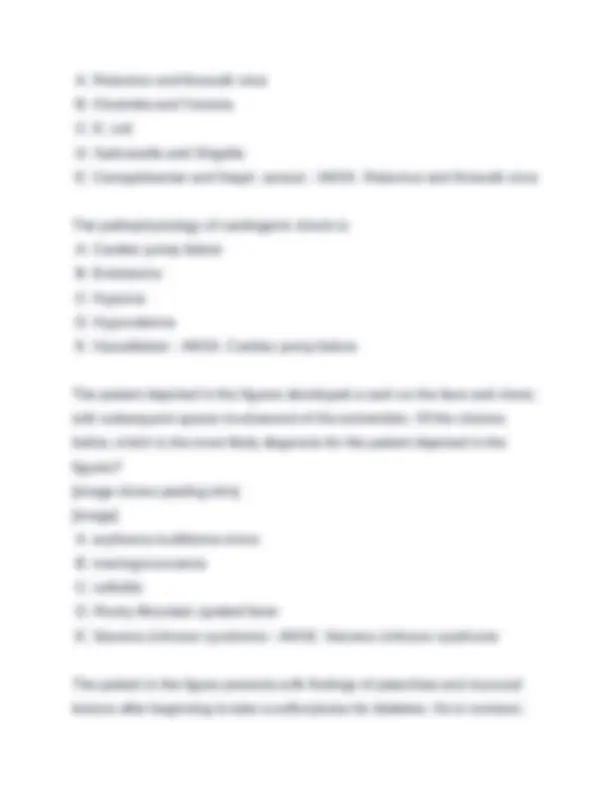
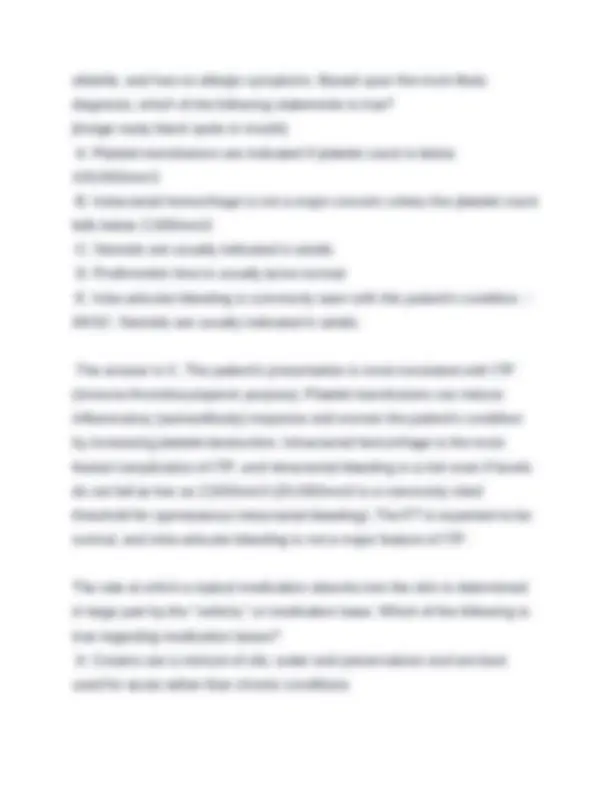
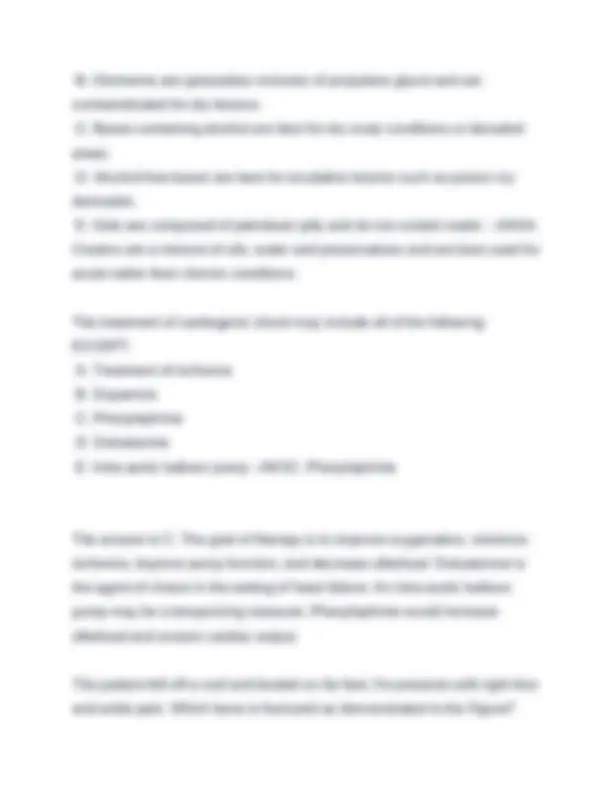
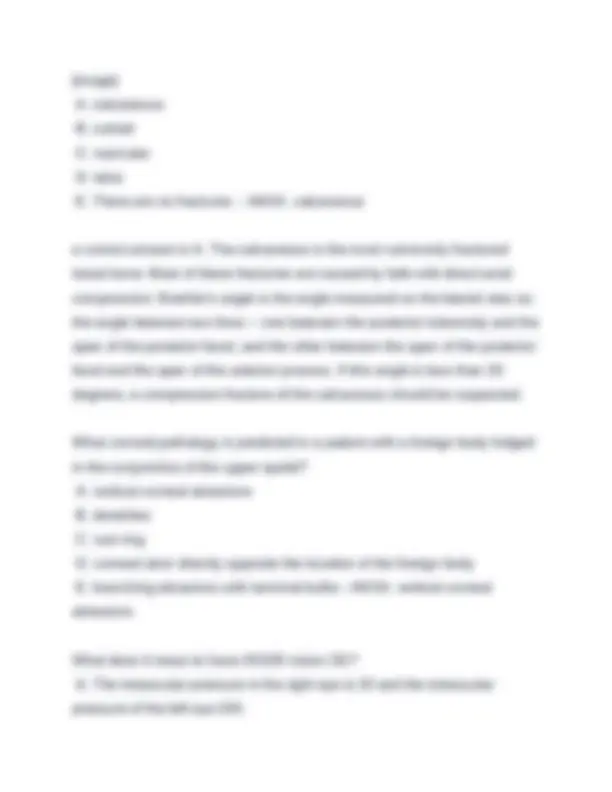
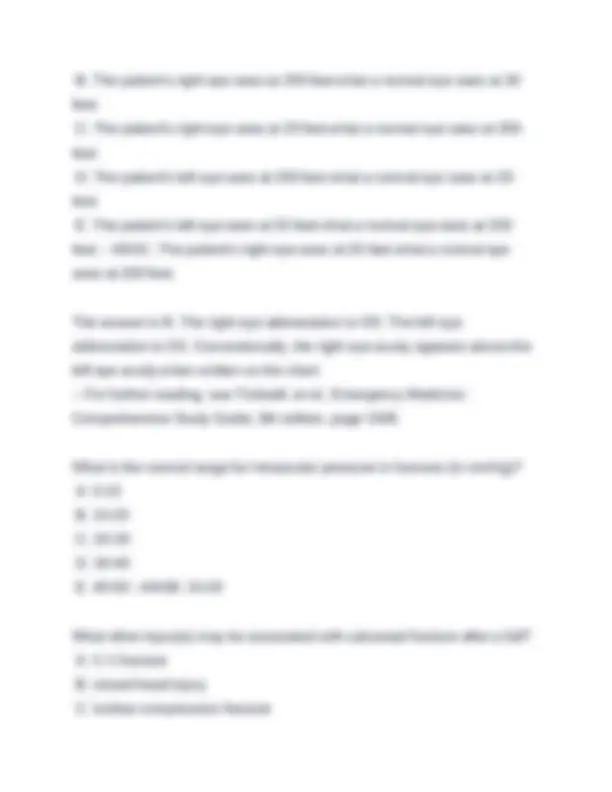
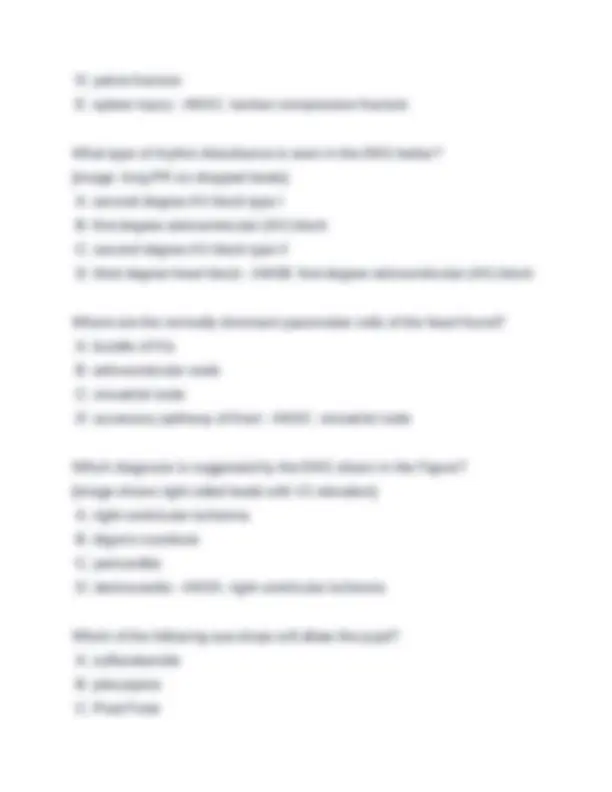
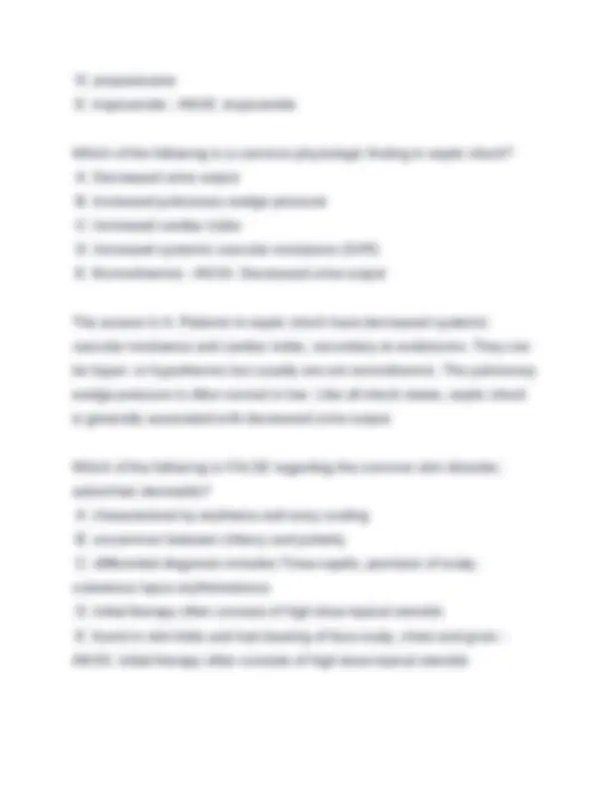
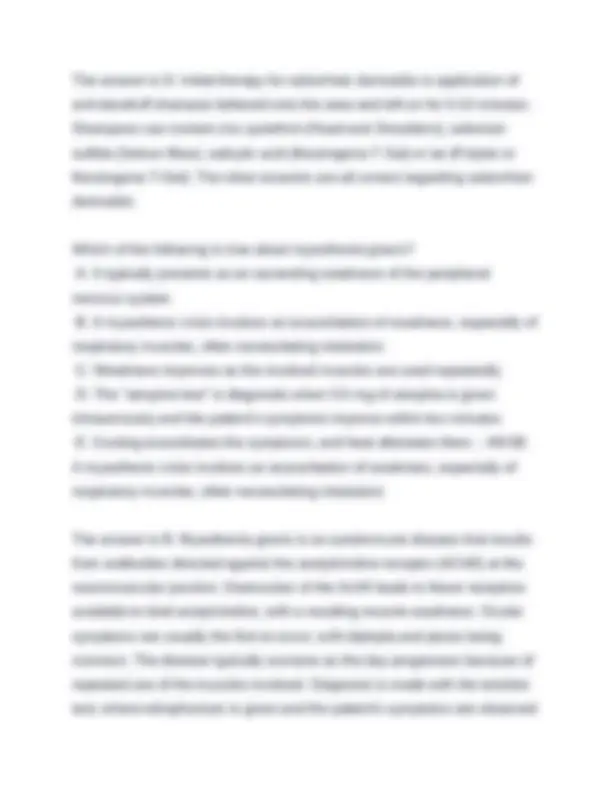
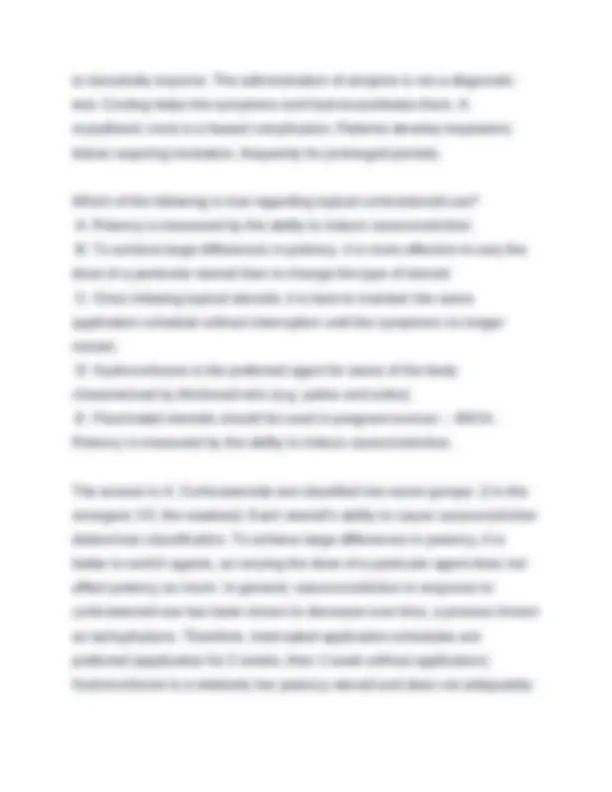
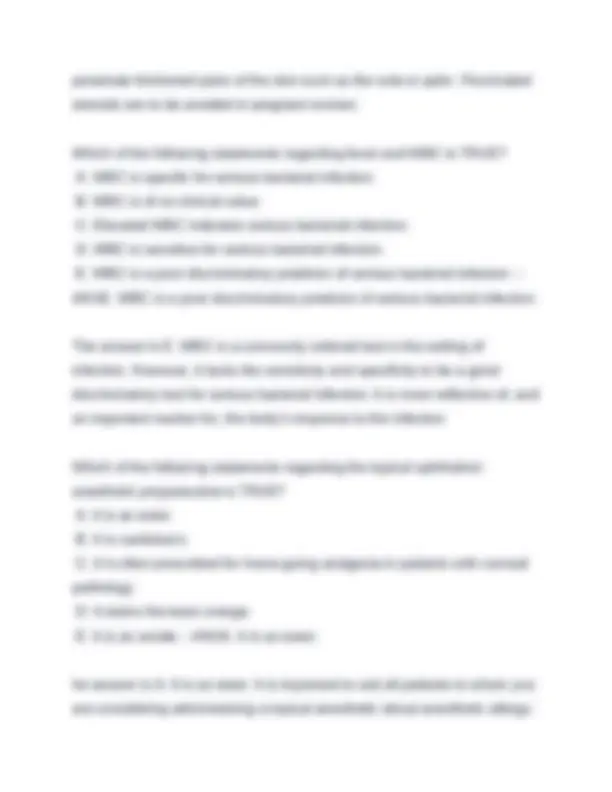
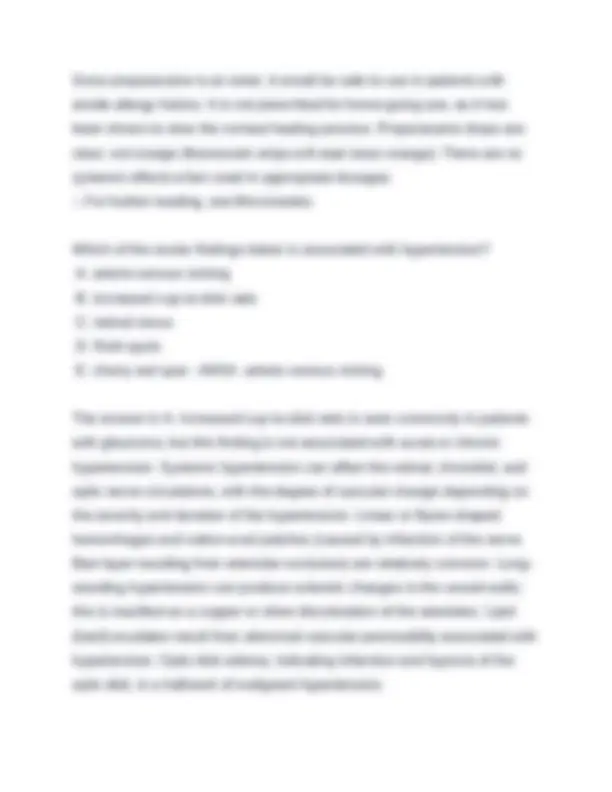
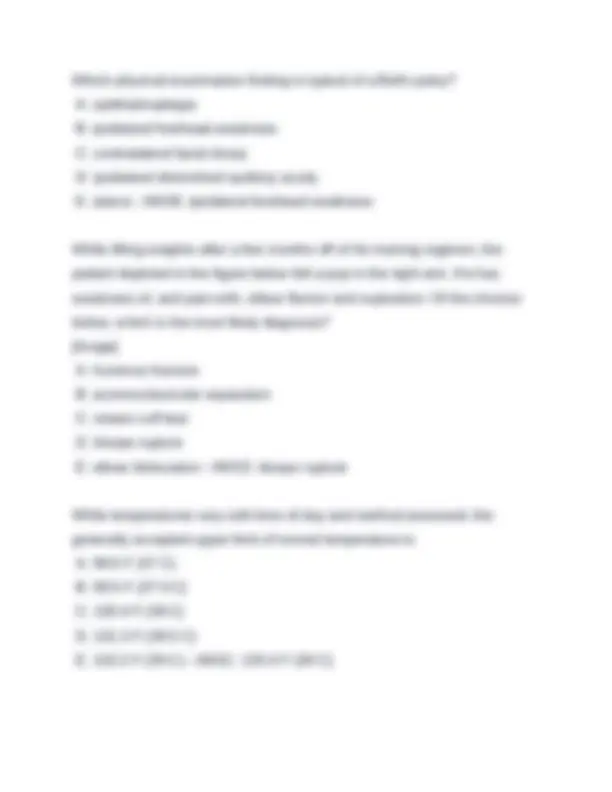
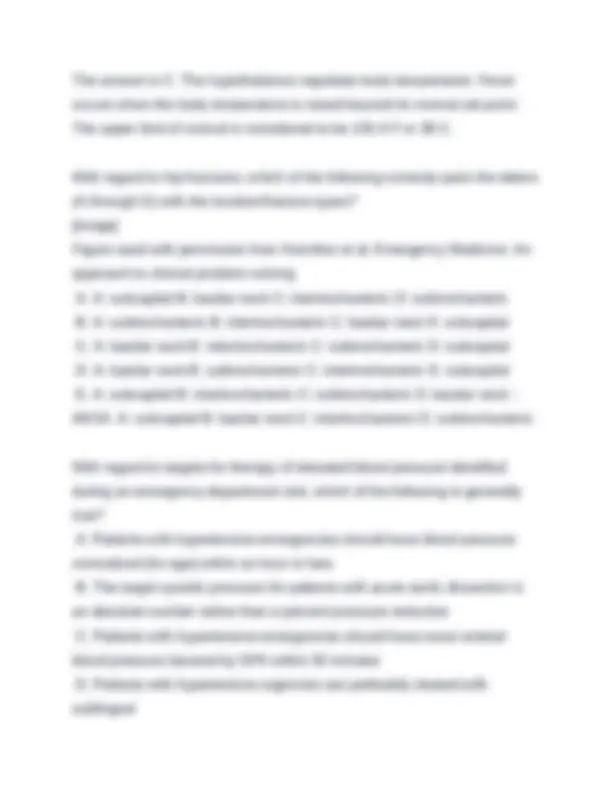
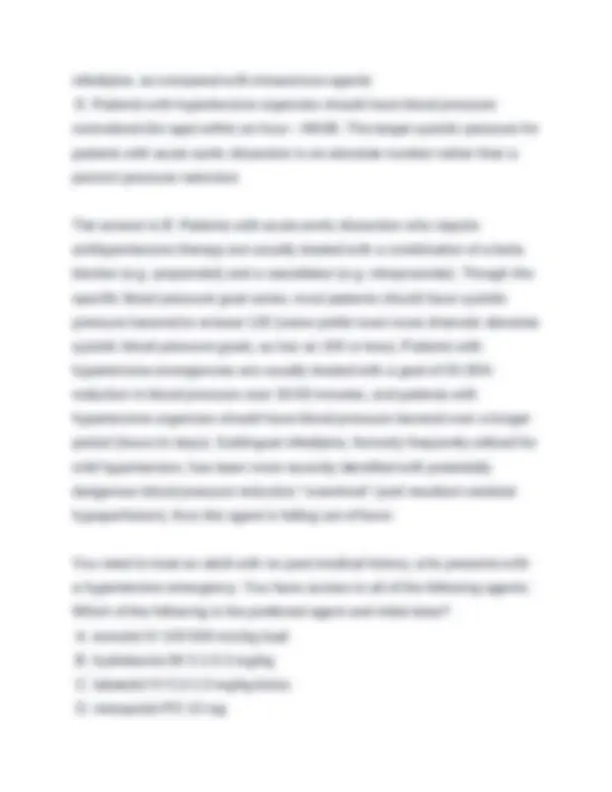
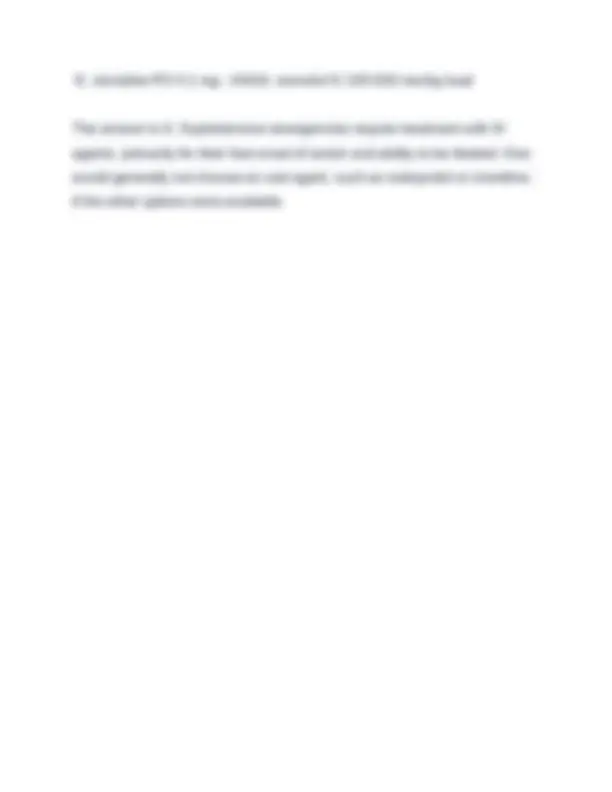


Study with the several resources on Docsity

Earn points by helping other students or get them with a premium plan


Prepare for your exams
Study with the several resources on Docsity

Earn points to download
Earn points by helping other students or get them with a premium plan
Community
Ask the community for help and clear up your study doubts
Discover the best universities in your country according to Docsity users
Free resources
Download our free guides on studying techniques, anxiety management strategies, and thesis advice from Docsity tutors
SAEM 241 – 390 Exam Test Bank. Questions with Correct Verified Answers 2025-2026. Graded A
Typology: Exams
1 / 89

This page cannot be seen from the preview
Don't miss anything!


















































































A 10 year old boy presents with high fever and a rash. The rash started on his wrists and ankles and has spread to his trunk, palms, and soles. The correct diagnosis is most likely: A. varicella B. Rocky Mountain spotted fever C. tinea D. Lyme disease E. scarlet fever - ANSB. Rocky Mountain spotted fever A 12 year old boy complains of a pruritic rash on his inner thighs and under his axilla. The rash is unresponsive to topical and oral antihistamines. On examination, one notes circular, raised nodules on an erythematous base. The rash appears as shown in Figure A below. (Figure B depicts a hand rash of identical etiology in an older patient.) Which of the following statements is FALSE regarding this rash? [image] Photo courtesy of eMedicine.com A. The parasite is a mite known as Sarcopetes scabii. B. Treatment is permethrin 5% cream applied to skin for 8-12 hours. C. Often this condition occurs in young adults by sexual contact or in the elderly hospitalized population.
D. Antibiotic therapy is contraindicated because it may exacerbate the underlying condition. E. The organism involved does not penetrate the dermis for it relies on oxygen for survival. - ANSD. Antibiotic therapy is contraindicated because it may exacerbate the underlying condition The answer is D. This condition is commonly associated with secondary bacterial infection and antibiotics may be indicated if signs of superinfection (i.e. surrounding erythema) are present. A 14 year-old child presents to the emergency department. His blood pressure is 210/140. He complains of a headache, nausea, and recent blurred vision. Of the following choices, the best goal for lowering his mean arterial blood pressure is to have it drop by: A. Until symptoms resolve B. 5% in the first 5-6 hours C. 25% in the first hour D. 50% in the first hour E. To normal for his age in the first hour - ANSC. 25% in the first hour The answer is C. A systolic BP of 210 or more, or a diastolic BP of 140 or greater, defines hypertensive urgency. With end-organs symptoms, as above, the presumptive diagnosis is hypertensive emergency. In hypertensive emergencies, the goal is to decrease mean arterial blood pressure by 10-25% within the first hour, thereby alleviating symptoms while not compromising cerebral perfusion.
A 19 year old male presents to the emergency department with allergic- mediated pruritis over large portions of his body. Which of the following is true regarding this condition? A. H2 antagonists such as ranitidine or famotidine have never been shown to provide benefit. B. Topical antihistamine agents should be encouraged to manage the pruritis. C. There is no role for therapies such as Domeboro solution (1:10 diluted aluminum sulfate soaks), potassium permanganate baths, and oat-meal baths. D. Oral doses of antihistamines should be encouraged initially. E. Second generation antihistamines such astemizole, fexofenadine, and loratadine are more effective but cause increased levels of sedation and should be avoided if possible. - ANSD. Oral doses of antihistamines should be encouraged initially. The answer is D. Oral administration of diphenhydramine or hydroxyzine (25 to 50 mg po q6H) is an appropriate adult dose and is effective for pruritis. Intravenous administration can also be used. Topical antihistamines are quickly absorbed, making it difficult to predict the actual dosing if a patient aggressively applies the preparation. Thus, use over large areas of the body should be avoided especially if the patient is currently taking oral antihistamine. The bath or soaking therapies are also recommended to control large areas of pruritis. Second generation antihistamines, although more costly, have lower dosing frequency requirements and cause less sedation.
A 19 year old man is stabbed in the left chest in the 3rd intercostals space just to the left of the sternum. His vital signs are: T 97.9, HR 130, BP 60/48, RR 18, SPO2 84%. He has significant JVD and his lungs are clear. The patient's diagnosis is: A. Tension pneumothorax B. Lung laceration C. Spinal cord injury D. Hypovolemic shock E. Cardiac tamponade - ANSE. Cardiac tamponade The answer is E. The patient has a stab wound to the left chest near the sternum. His hypotension, clear lungs, and JVD suggest an obstructive shock. He likely has cardiac tamponade and needs emergent decompression either with pericardiocentesis or pericardial window. A 19 year old with eczema (atopic dermatitis) presents to the urgent care clinic demonstrating pustules within an area affected by his chronic eczema. A Tzanck preparation yields positive results, confirming the diagnosis of eczema herpeticum. Which of the following is FALSE regarding this condition? A. It is often mistaken as an exacerbation or a superimposed impetigo infection. B. Constitutional symptoms and adenopathy are often present. C. Death from this condition is very rare. D. It can be caused by either HSV or VZV.
diagnosed in infancy. Another consideration in this patient would be epiglottitis; however, given her vaccination history, she would be less likely to contract epiglottitis from H. influenzae Type b, which is the most common causative organism. A 2 year old male is brought to the ED in status epilepticus. He has not responded to adequate doses of benzodiazepines. Which of the following possible causes of a seizure must be evaluated for in the emergency department? A. Hypoxia B. Hypoglycemia C. Toxic ingestion D. Head trauma E. All of the above possible causes must be evaluated for - ANSE. All of the above possible causes must be evaluated for The answer is E. Seizures have a number of secondary causes, which must be identified and corrected before the seizure will end. Hypoxemia and hypoglycemia are easily detected by pulse oximetry and bedside measurement of glucose, respectively. Toddlers may ingest many toxins accidentally, such as INH, tricyclic antidepressants, and camphor. Trauma must be considered, too, including child abuse. Sickle cell disease, SLE, and leukemia are some of the medical causes of seizures and status epilepticus. A 20 year old college female recently returned from spring break after hiking in the Virginia woods approximately two weeks prior to her
presentation to the E.D. One day prior to presentation, she developed fever, chills, and anorexia. In the emergency department, she complains of headache, photophobia, and myalgias. On exam, one notices a disseminated, non-blanching, papular rash. Which of the following statements regarding this condition is FALSE? A. It is caused by the tick borne parasite Rickettsia rickettsii. B. 95% of patients develop symptoms between the period of April 1 and September 30. C. Characteristically the rash begins on the trunk and spreads to the extremities. D. A skin biopsy shows a necrotizing vasculitis. E. If untreated, fatality rates range between 25-50%; however, treatment reduces the rate to 10%. - ANSC. Characteristically the rash begins on the trunk and spreads to the extremities. The answer is C. Rocky Mountain Spotted Fever characteristically begins on wrist, forearms, and ankles. Within 6-18 hours, the rash spreads centripetally to the arms, thighs, trunk, and face. A 20 year old man used his left hand to punch another person in a bar fight. The man complains of pain and swelling over the ulnar aspect of his hand. His X-ray is shown in the Figure. What type of fracture does he have? [image] A. Bennett's fracture B. Boxer's fracture C. Colles' fracture
C. fluorescein examination of the right cornea D. Removal of the foreign body with a moistened cotton swab - ANSD. Removal of the foreign body with a moistened cotton swab The answer is D. The cornea is one of the most sensitive parts of the body. Tiny foreign bodies (such as the one in the Figure) lying on the surface of the cornea or on the underside of the eyelids can cause tremendous discomfort as they stimulate thousands of corneal nerve fibers with each blink. The patient may not see the foreign body but will complain of tearing and conjunctival reddening. It is important to differentiate between intraocular and extraocular foreign bodies. Intraocular foreign bodies (those that penetrate the globe) may diminish visual acuity by distorting the lens or by causing a vitreal hemorrhage. Extraocular foreign bodies are unlikely to diminish visual acuity unless they lie directly in the visual axis (in line with the pupil). In either case, the patient presenting to the emergency department with a suspected ocular foreign body should receive an eye examination that includes testing of visual acuity while the patient wears corrective lenses (not contact lenses). The proper management of a suspected foreign body includes eversion of both lids, which in this case, resulted in identification of the foreign body. A moistened cotton swab easily removes a foreign body on the palpebral conjunctiva. Fluorescein should then be applied to the cornea. Using a magnifying glass or a slit lamp, examine the cornea for epithelial defects. If a corneal abrasion is identified, the patient should refrain from wearing contact lenses until it has healed. Wearing contact lenses over a corneal
epithelial defect predisposes the patient to forming an infectious corneal ulcer. There is no need to patch the eye because patching confers no benefit in healing corneal abrasions. A 22 year old female presents to the emergency department with a "funny feeling" in her chest. She has had similar episodes but never lasting as long as the current episode (3-hour duration). Her heart rate is 200, blood pressure is 128/68, respiratory rate is 20 and her pulse oximetry is 96%. Her EKG is shown in the Figure. The best treatment option for this patient is: [image shows narrow complex tachy] A. cardioversion B. lidocaine C. adenosine D. verpamil - ANSC. adenosine The answer is C. The rhythm shown in the EKG is a narrow complex regular tachycardia. It could also be described as a supraventricular tachycardia (SVT). The first-line treatments of stable SVT are vagal maneuvers or adenosine. Unstable SVT (such as that causing hypotension, heart failure, or myocardial ischemia) should be cardioverted.
The answer is A. T"The classic WPW syndrome consists of tachycardia with the following three features: a short P-R interval (<0.12 second), QRS duration greater than 0.10 second, a slurred upstroke to the QRS complex, referred to as a delta wave." A 24 year old female presents with fever, vomiting, right flank pain, and dysuria. Her UA reveals leukocyte esterase. The correct diagnosis is: A. Choleycystitis B. Cystitis C. Right lower pneumonia D. Pyelonephritis E. Appendicitis - ANSD. Pyelonephritis A 24 year old woman presents with difficulty breathing after eating Chinese food. Her vital signs are: T 97.9, HR 120, BP 80/40, RR 28, SPO2 86%. Her voice is hoarse and her lung auscultation reveals wheezes. She has no JVD. The patient's most likely diagnosis is: A. Anaphylactic shock B. Cardiogenic shock C. Spinal shock D. Pulmonary embolism E. Acute myocardial infarction - ANSA. Anaphylactic shock The answer is A. The patient's respiratory symptoms, absence of JVD, and vital signs suggest anaphylaxis (distributive shock). The proximity of symptoms to ingestion of food also suggests an allergic reaction.
A 24 year old woman, brought by her sister, enters the emergency department. The 24 year old is writhing in pain, clutching her abdomen and shivering. Her sister states that the patient had a therapeutic abortion performed 3 days ago and has been having worsening abdominal pain ever since. The patient's vital signs are: T 103.4 F, HR 128, BP 104/72, RR 28, O2 saturation 100% in room air and she has marked lower abdominal pain and voluntary guarding. The most appropriate steps in treatment for this woman's condition include all of the following EXCEPT: A. broad-spectrum antibiotics B. laboratory studies including basic chemistry, complete blood count with differential, coagulations studies, DIC panel, serum pregnancy test, and blood cultures C. urgent ob/gyn consult to facilitate rapid transport of patient to the operating room D. intravenous fluids E. high-dose steroids - ANSE. high-dose steroids The answer is E. This patient is most likely suffering from a septic abortion in which retained products of conception developed a local infection. This infection has now spread systemically causing the systemic inflammatory response and potentially causing sepsis. Immediate intravenous fluids and broad-spectrum antibiotics are necessary; however, steroids are contraindicated in such a situation and could worsen the infection. The patient needs to be taken to the OR urgently to remove the retained products of conception.
blood is another option, but usually takes at least 15-20 minutes to obtain; cross-matching of blood takes even longer. A 28 year old female is 4 months pregnant and presents with dysuria. Her UA reveals leukocyte esterase and nitrates. Of the following, the best treatment is: A. Amoxicillin B. Macrodantin (nitrofurantoin) C. Ciprofloxacin D. Doxycycline E. Bactrim - ANSB. Macrodantin (nitrofurantoin) A 3-week old presents to the emergency department with a fever of 100.8. The child is otherwise well appearing. After blood culture, the best management of the options below is: A. Check WBC before further management. B. UA plus urine culture, LP, antibiotics, and admit C. Discharge home D. ampicillin and discharge E. Admit for observation. - ANSB. UA plus urine culture, LP, antibiotics, and admit The answer is B. Fever in a child less than 30 days can be a marker for bacteremia, sepsis, and meningitis. Clinical findings are notoriously unreliable in this age group. The work up is fairly straightforward. Blood culture, urine culture and LP are required. After the work up, the child should be started on antibiotics. Ampicillin and gentamycin is the preferred
regimen in this age group. In a child 30-90 days old, there is controversy regarding the management algorithm. Some authorities treat all children under 90 days of age the same; others risk-stratify and perform selective work ups. A 32 year old male, intravenous heroin abuser, presents with a one-day history of mid-back pain, progressive weakness of his legs, and an inability to urinate. He has a temperature of 38.3° C (100.8° F). On exam, absent patellar deep tendon reflexes are noted, he cannot stand or walk, a distended bladder is palpable, and he has tenderness to palpation over his T10 and T11 vertebrae. Which of the following is not an acceptable next step? A. MRI of the spine B. Analgesia C. Foley catheter to drain the bladder D. Hospital admission for neurosurgical consultation in the morning E. Antibiotics to cover a broad spectrum of organism - ANSD. Hospital admission for neurosurgical consultation in the morning he answer is D. A spinal epidural abscess is a neurosurgical emergency, with the outcome being dependent on the speed of diagnosis and surgical decompression. Consequently, urgent neurosurgical evaluation is required. Although an uncommon disease, intravenous drug abuse, diabetes mellitus, chronic renal failure, and immunosuppression are risk factors for its development. Antibiotics to cover Staph. aureus, the most common cause, gram negative bacteria, and anaerobes are needed. Bladder decompression for symptomatic relief is important, as is analgesia
points away from orthopedic trauma.) The rash appearance renders a simple ecchymosis or contusion (choice A) unlikely. The characteristic dermatomal distribution of this rash makes a bacterial infection (choice D) much less likely than herpes zoster. Shingles was classically treated with analgesics only, but addition of acyclovir (choice B), if begun within the first several days of the rash, can reduce the incidence of post-herpetic neuralgia. A 33 year old female presents to the ED with acute onset of pain in the right foot, first metatarsophalangeal joint. She had a renal transplant 10 years ago, and her only medication is cyclosporine. Regarding this patient's condition, which of the following is true? [image] A. Inability to bear weight on the involved foot is a sign that the diagnosis is not gout, but rather a pathological fracture. B. In about 80% of cases, podagra is accompanied by concomitant involvement of another joint. C. Premenopausal females, compared to males of the same age, are more likely to develop gout. D. Colchicine may result in symptomatic improvement in patients with either gout or pseudogout. E. Though uric acid levels may be normal between gouty attacks, uric acid is virtually always elevated during an acute episode of gout. - ANSD. Colchicine may result in symptomatic improvement in patients with either gout or pseudogout.
A 35 year old male presents with right knee swelling (see Figure), redness and pain for 1 day. He has no medical problems. He has had no injury to his knee. His oral temperature is 101.9 and he appears ill. What is the next course of action? [image] A. arthrocentesis B. radiograph of joint C. medication for presumed gout and discharge D. knee immobilizer E. none of the above - ANSA. arthrocentesis A 35 year old woman presents complaining of left wrist pain for several months. She works as a waitress and has noticed increasing wrist pain associated with intermittent numbness and tingling of her thumb, index finger and long finger on the left hand. She states the pain is worse at night and after work. On exam she has tingling in her left thumb and first digit when her wrists are held in flexion for 60 seconds. This is a positive ____________ test and suggests the diagnosis of ______________. A. Finkelstein test/De Quervain's tendonitis B. Phalen's test/carpal tunnel syndrome C. Phalen's test/ulnar nerve compression D. Tinel's sign/carpal tunnel syndrome E. Tinel's sign/radial nerve compression - ANSB. Phalen's test/carpal tunnel syndrome A 36 year old woman on chronic cyclosporine treatment for bilateral lung transplantation visits the emergency department complaining of extreme